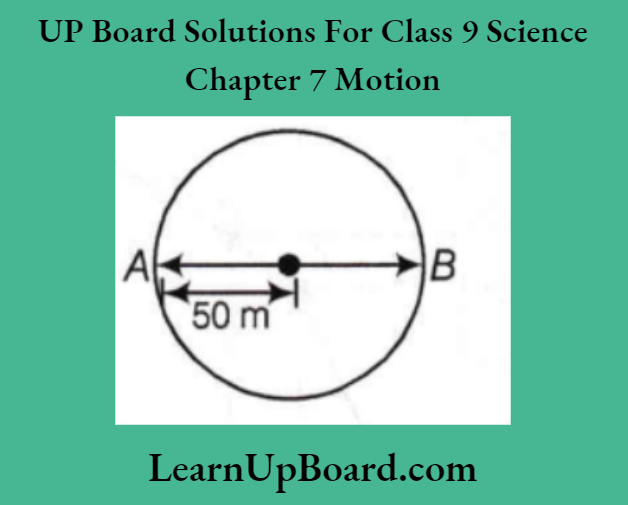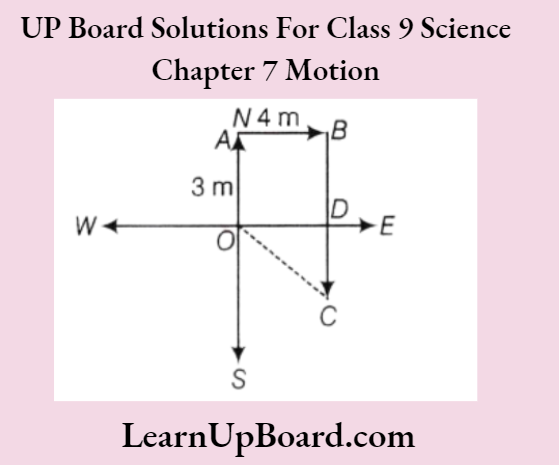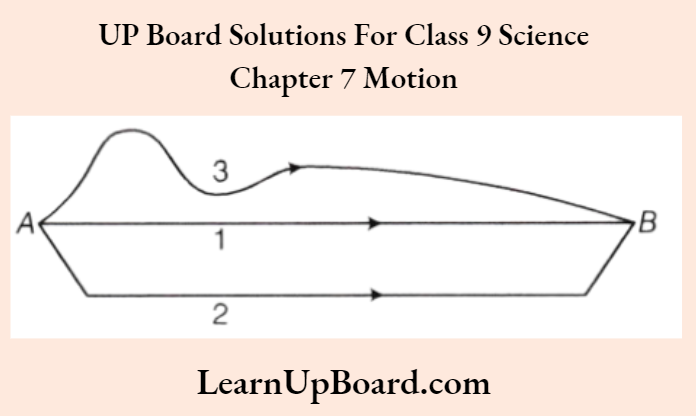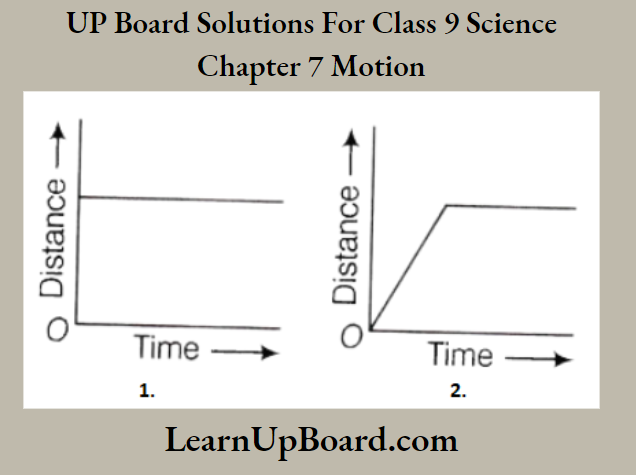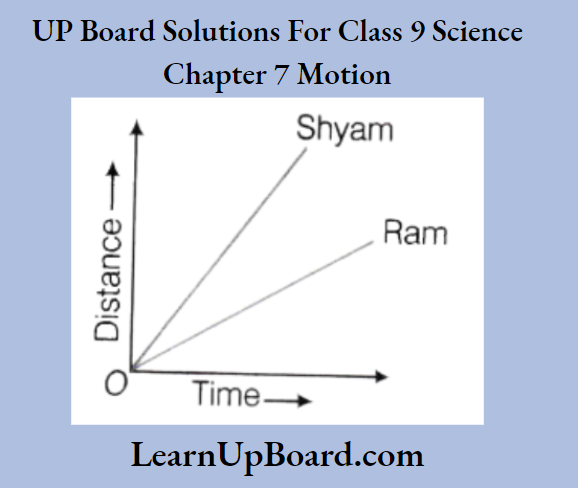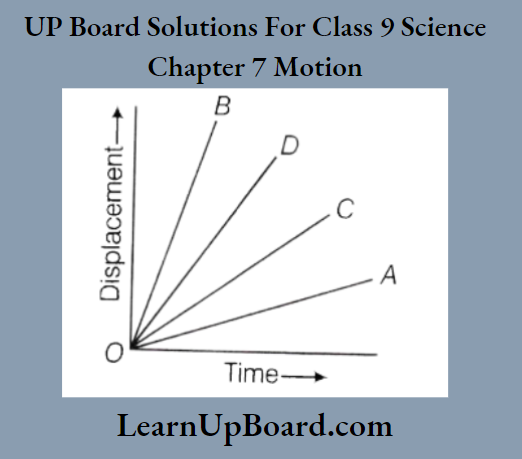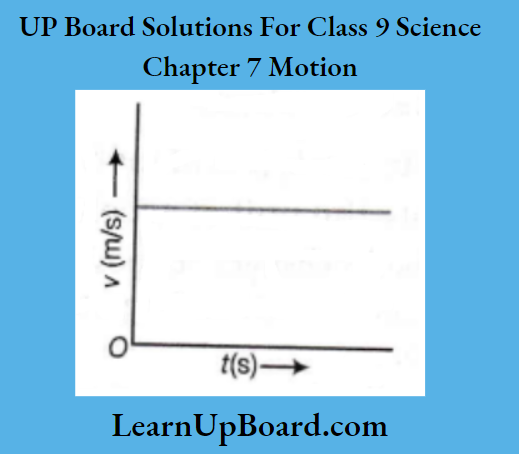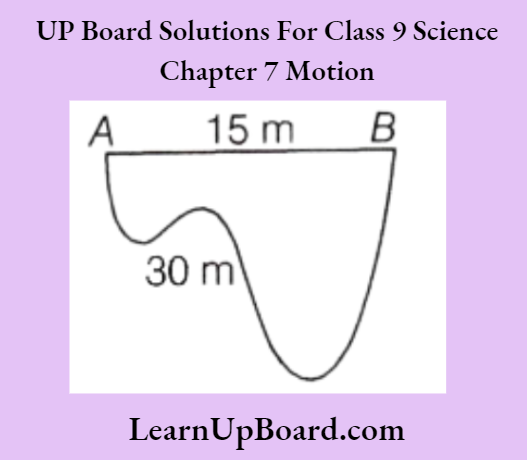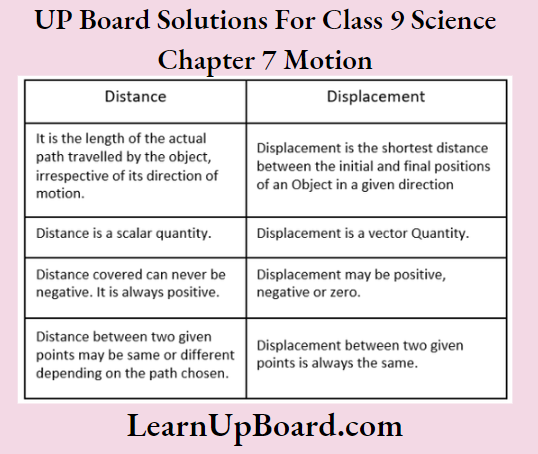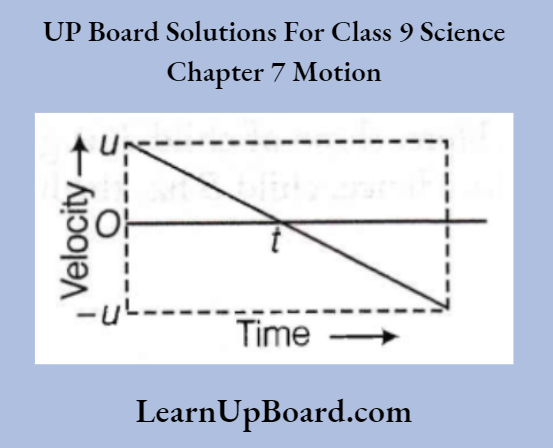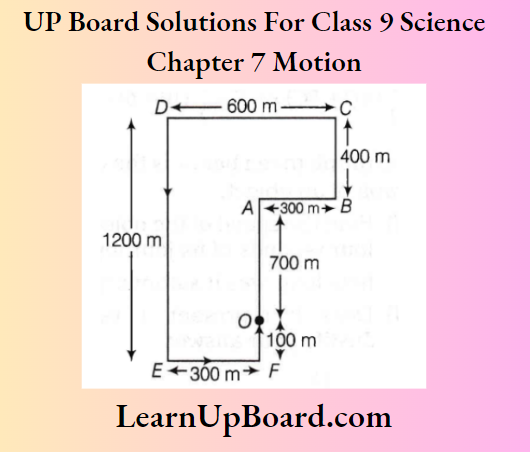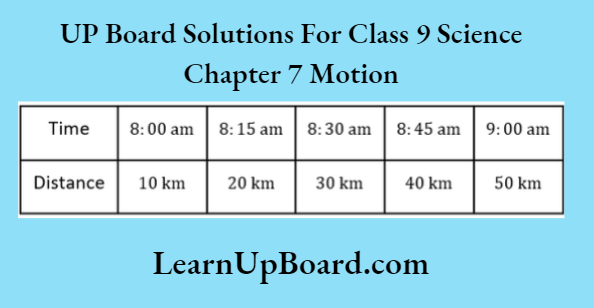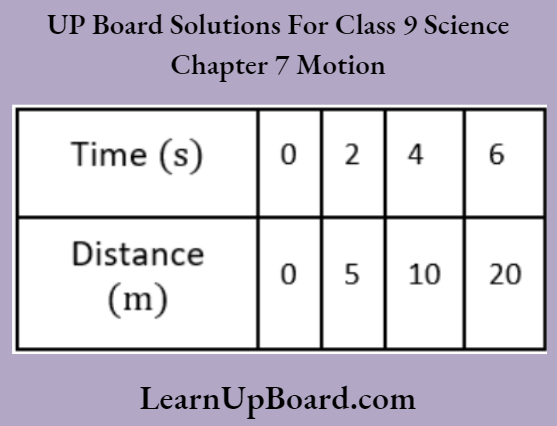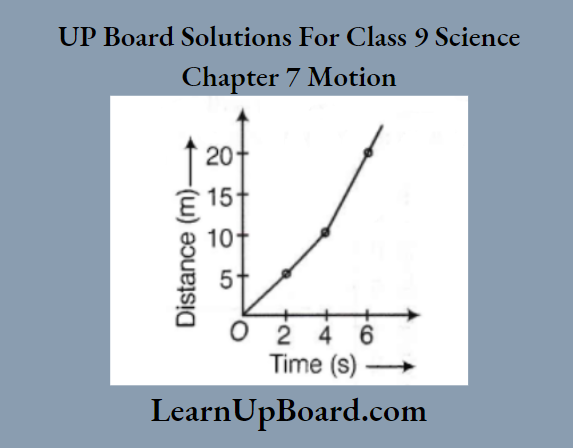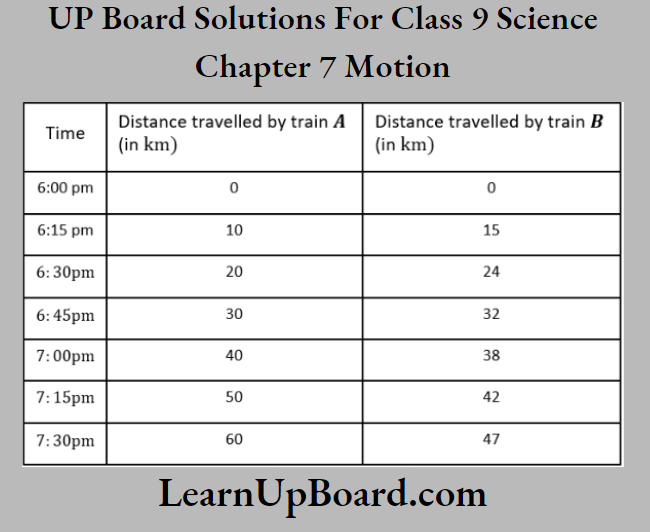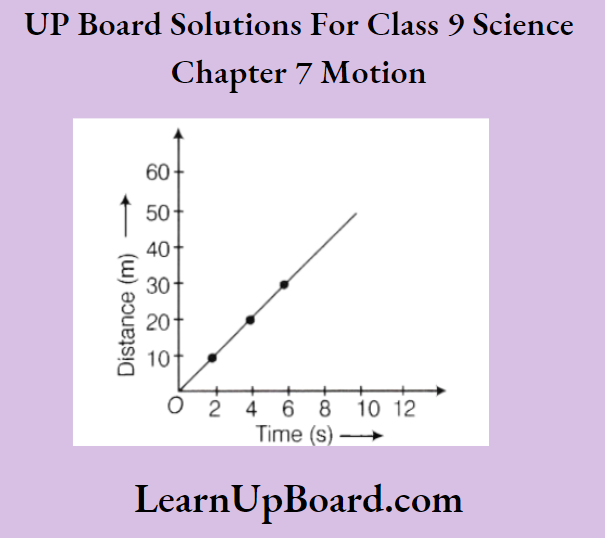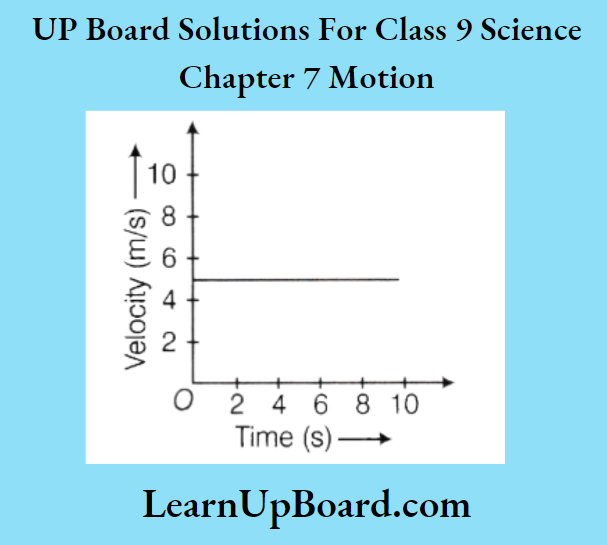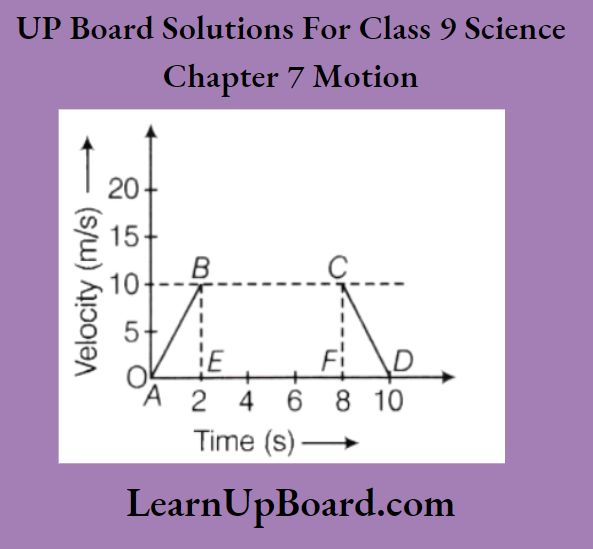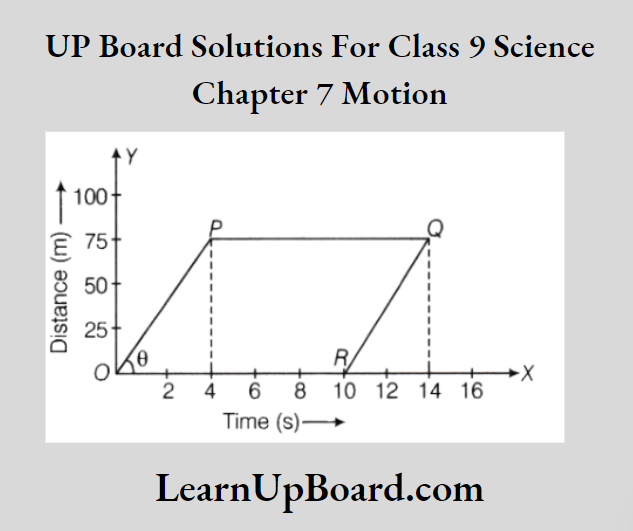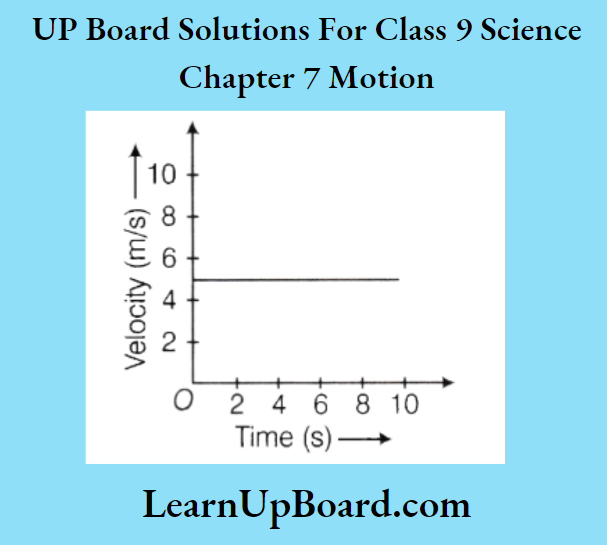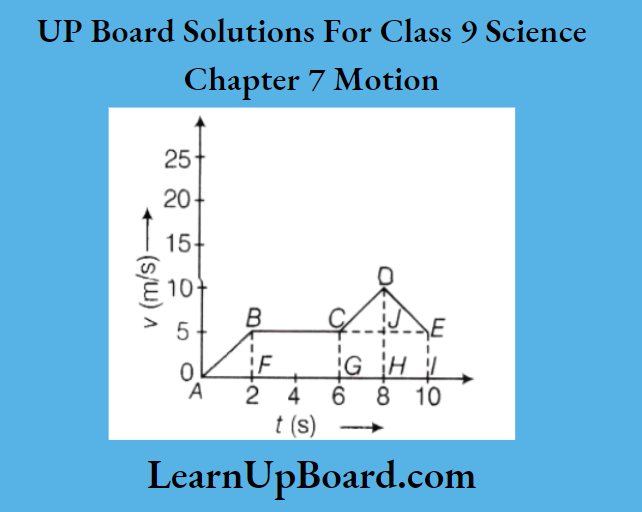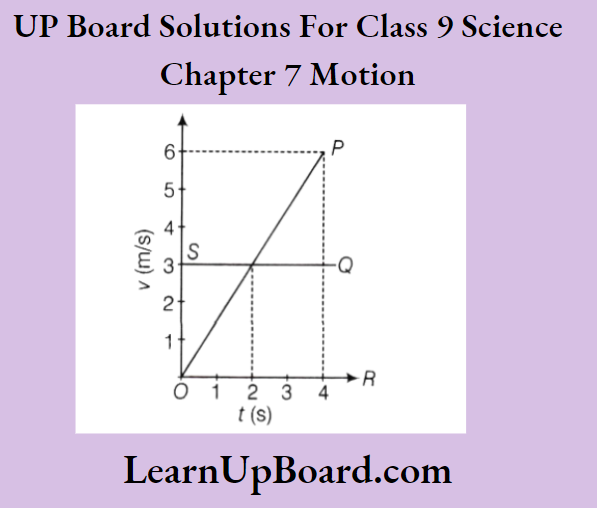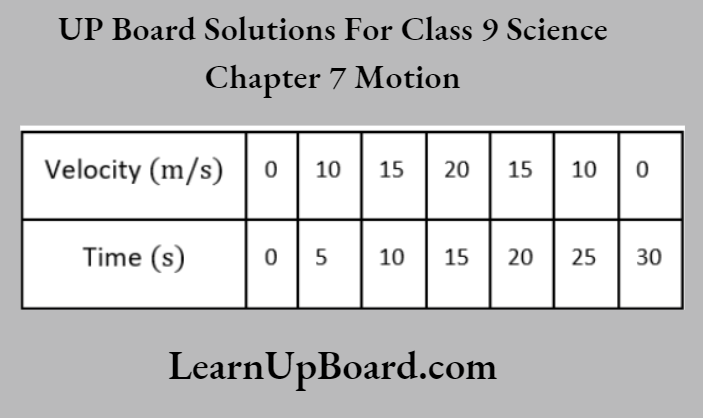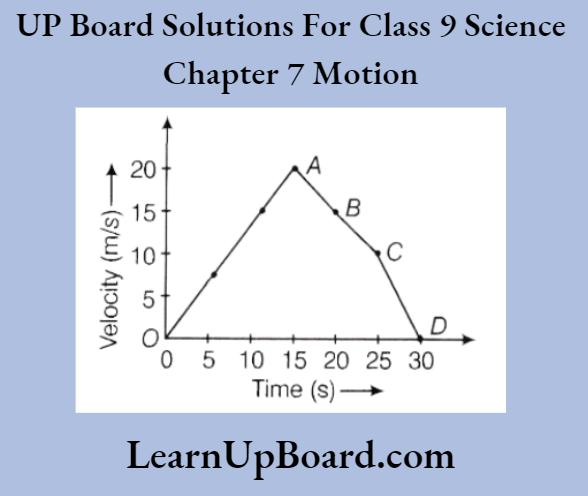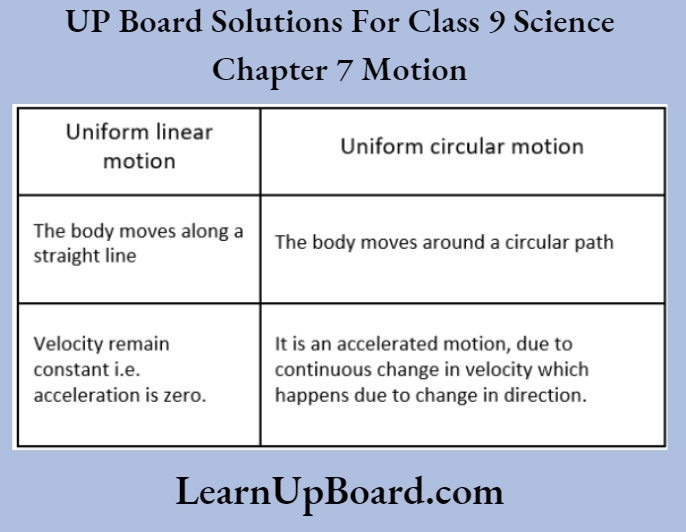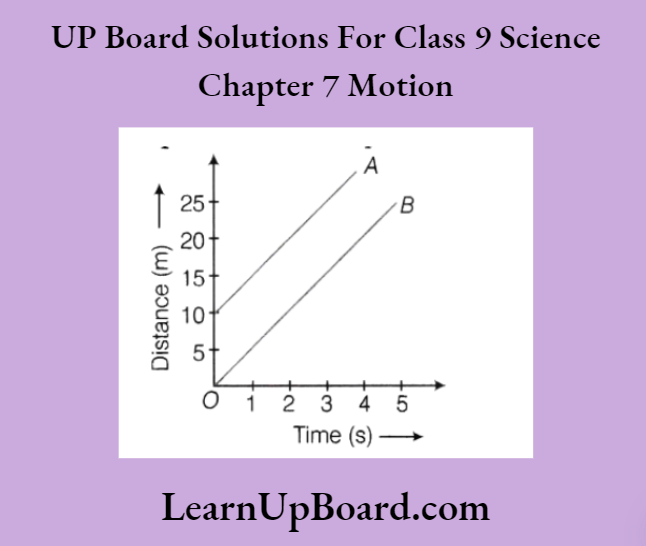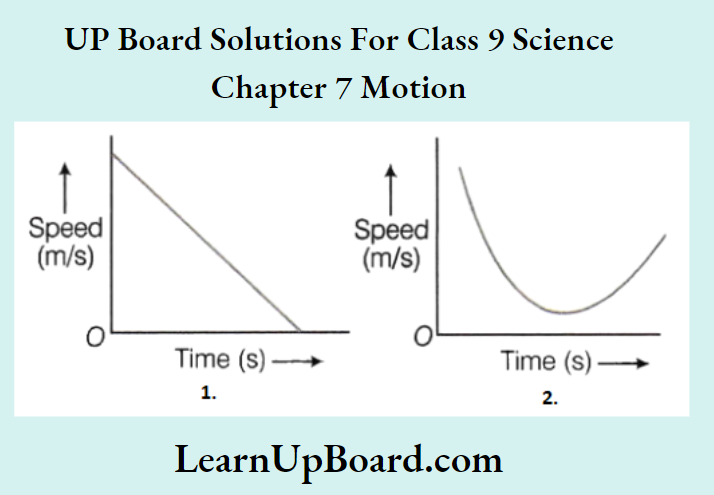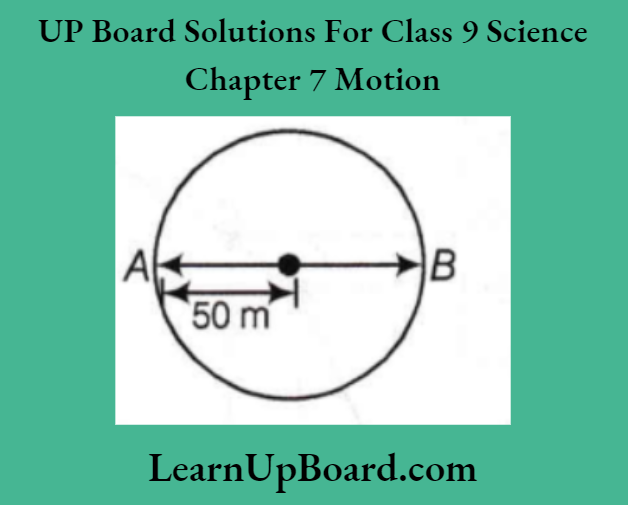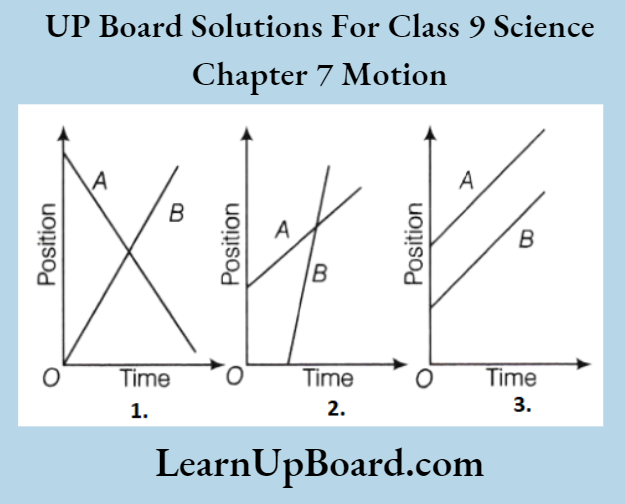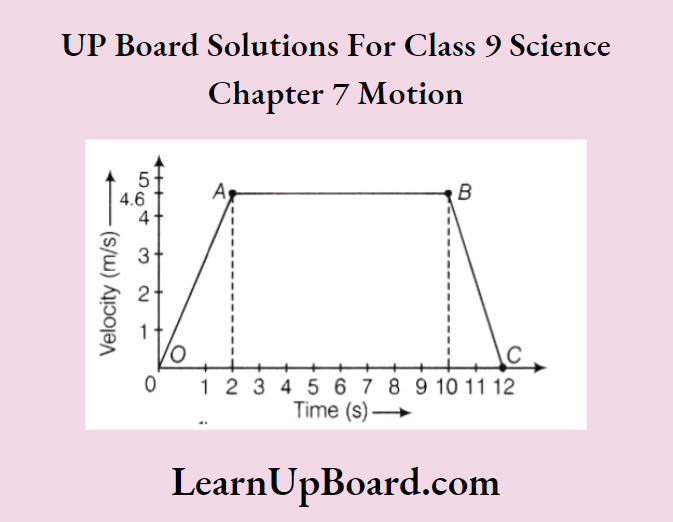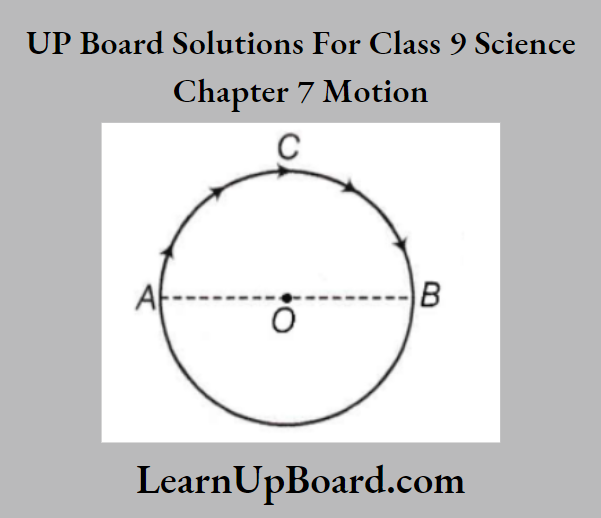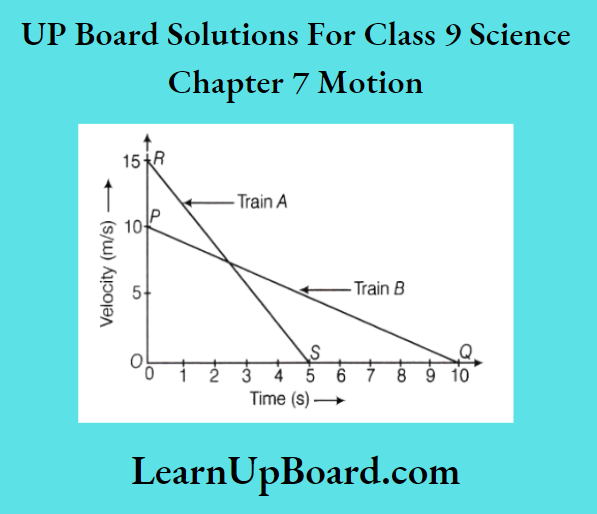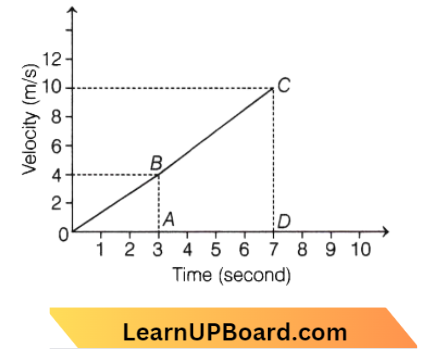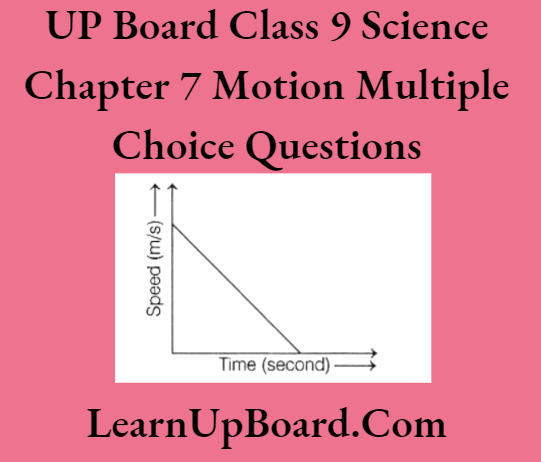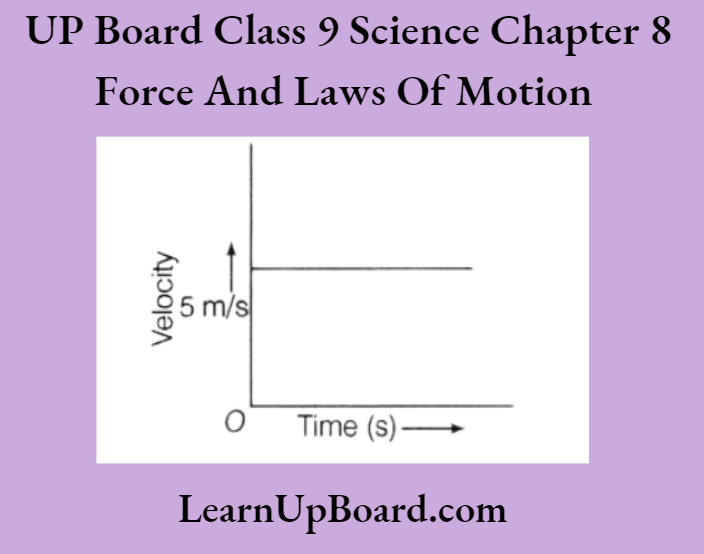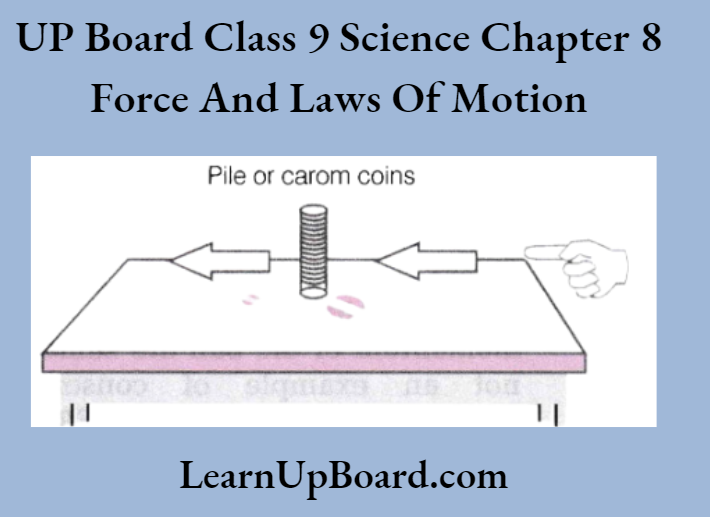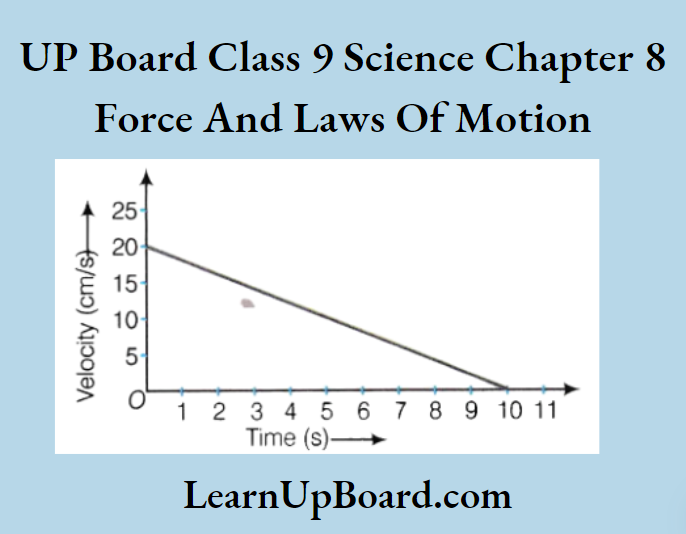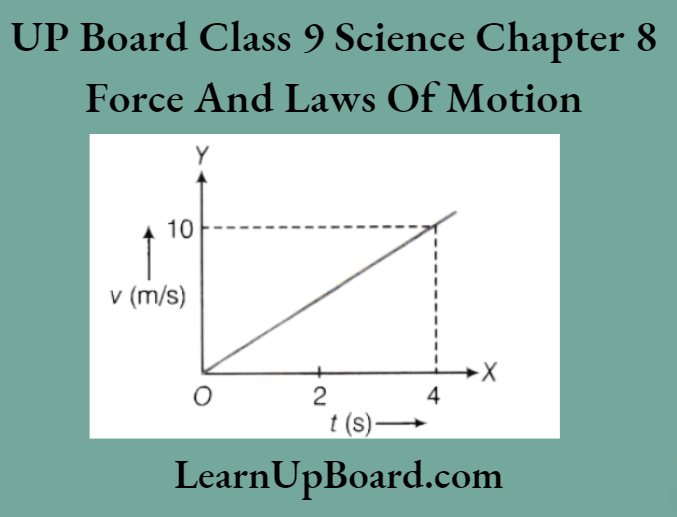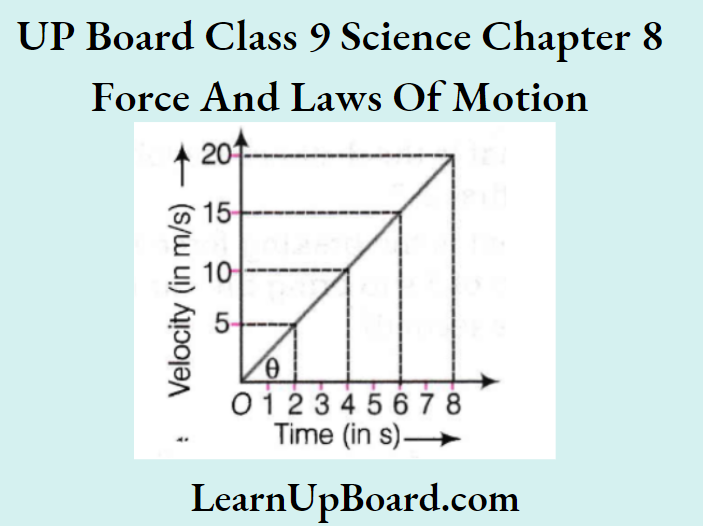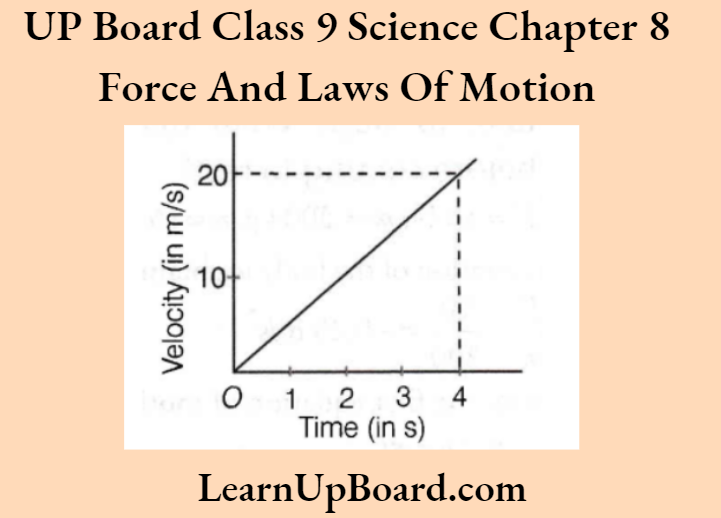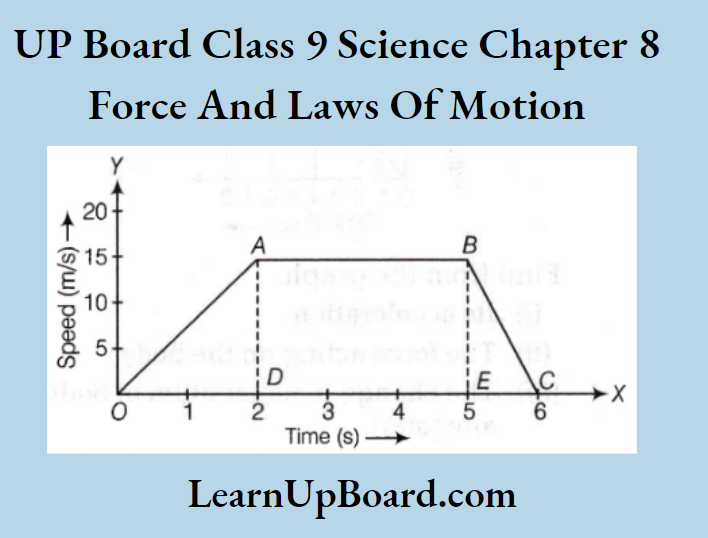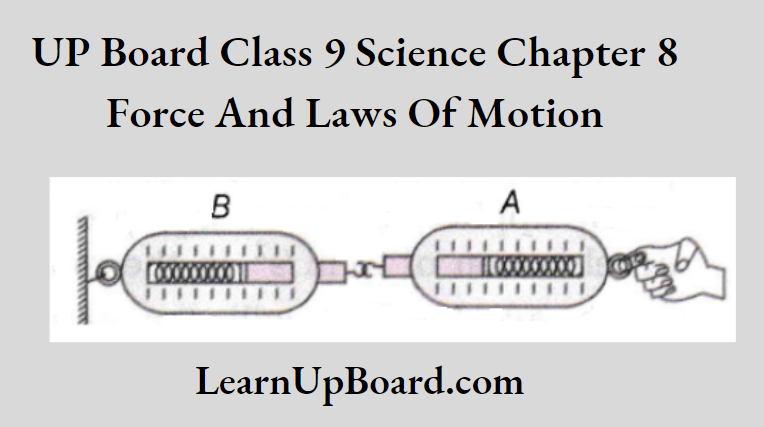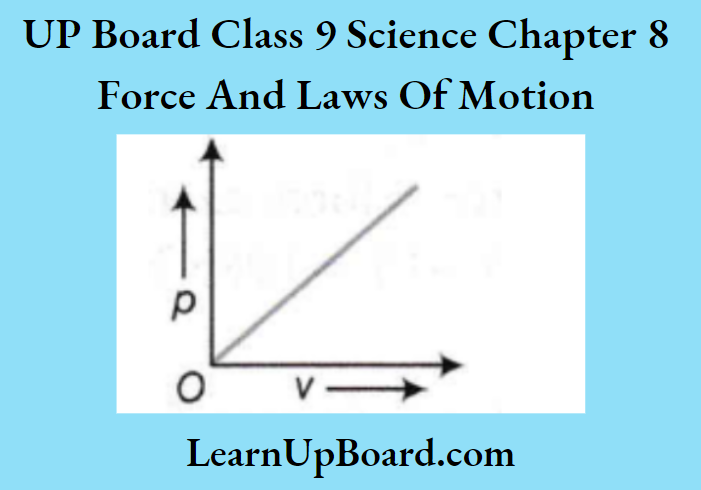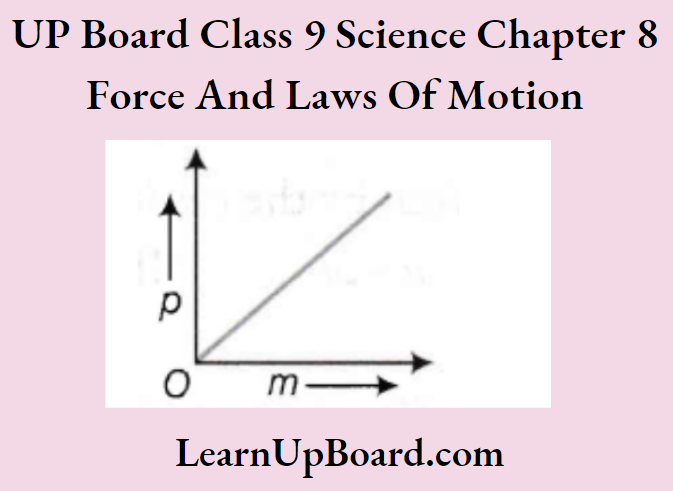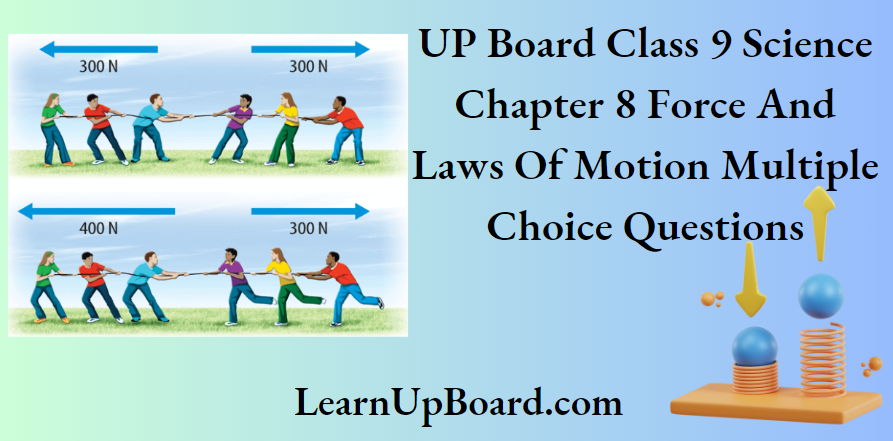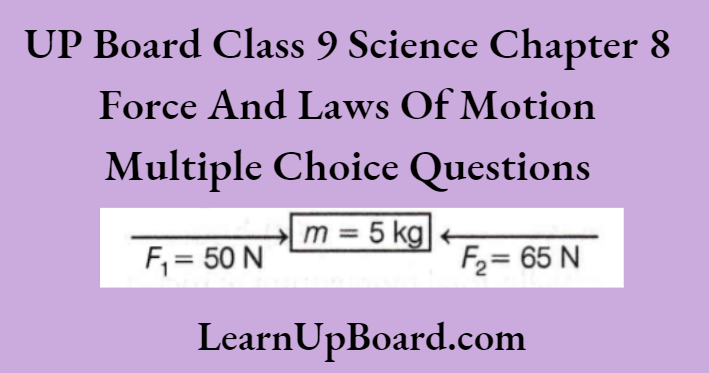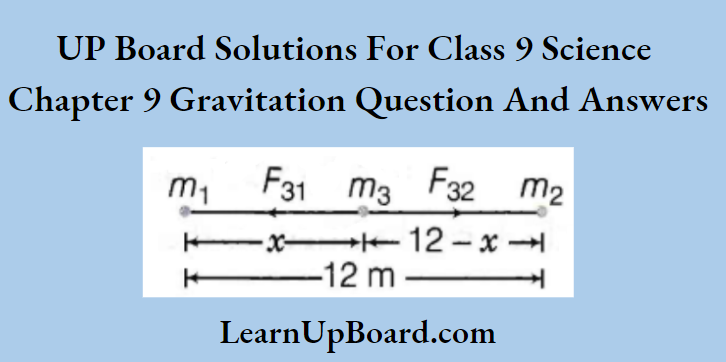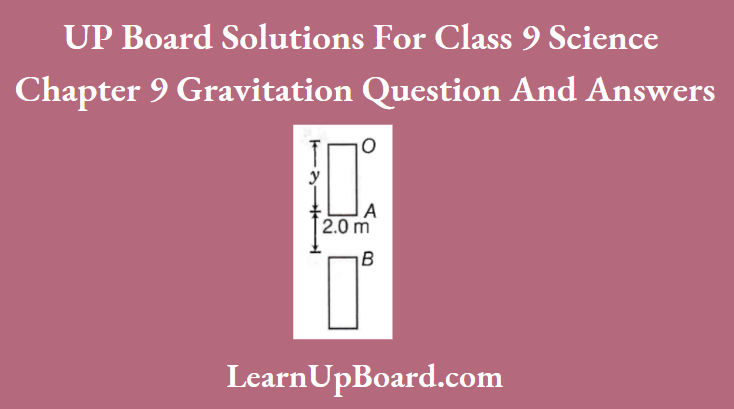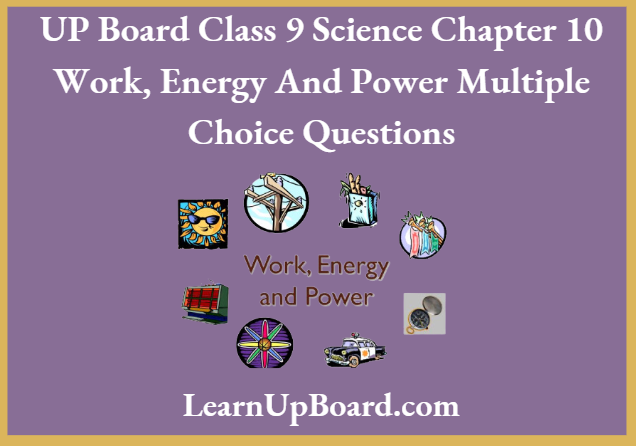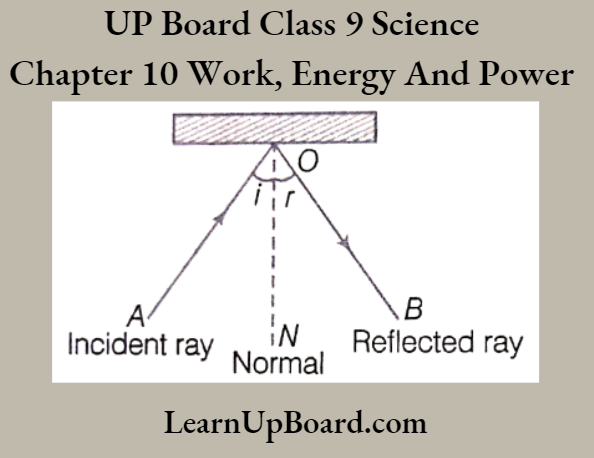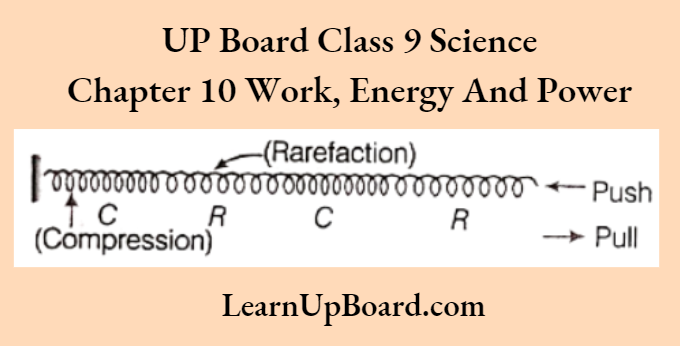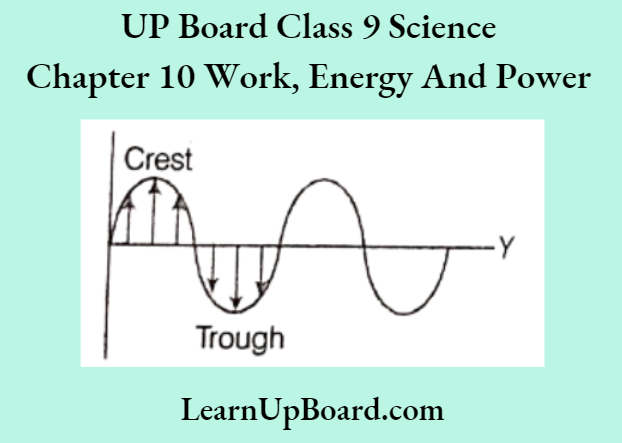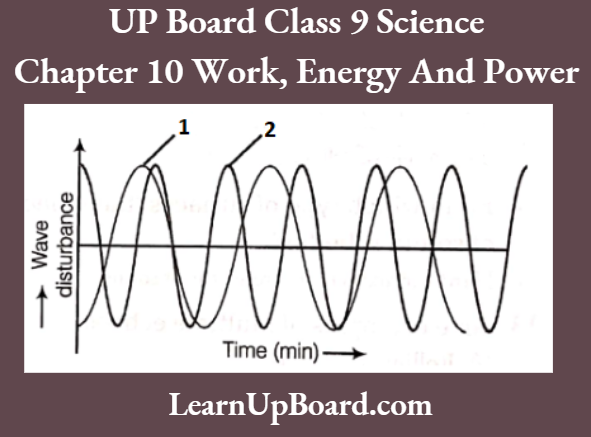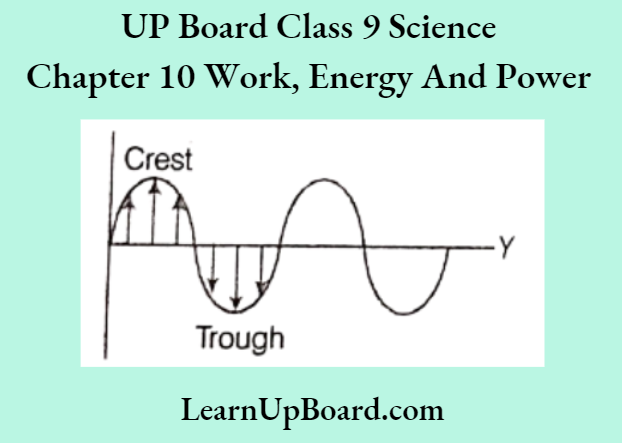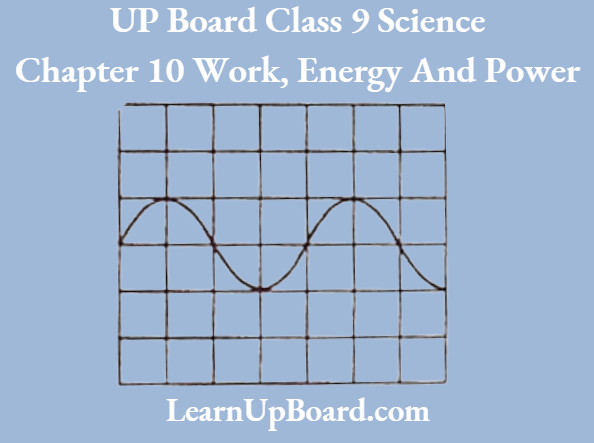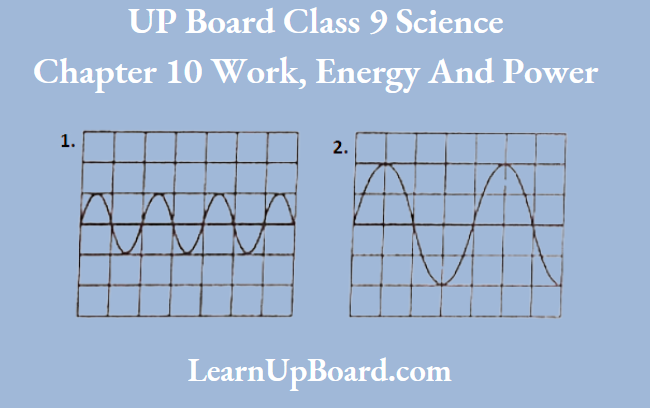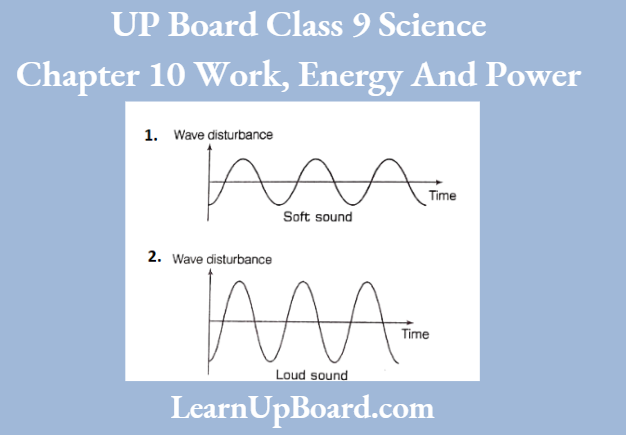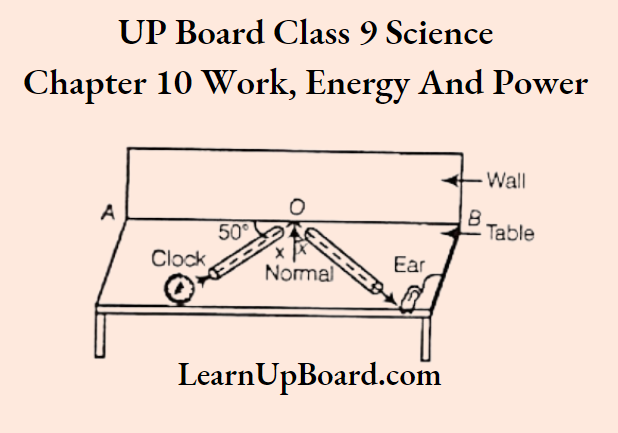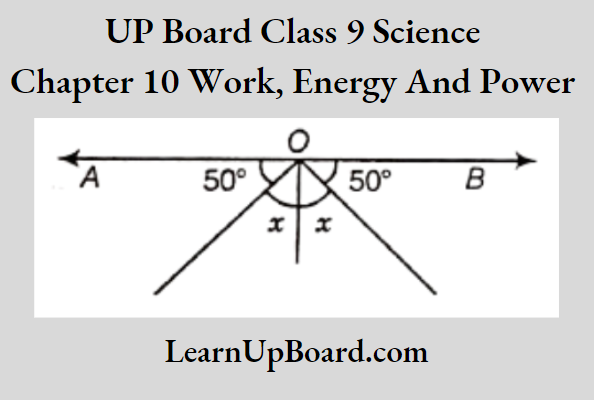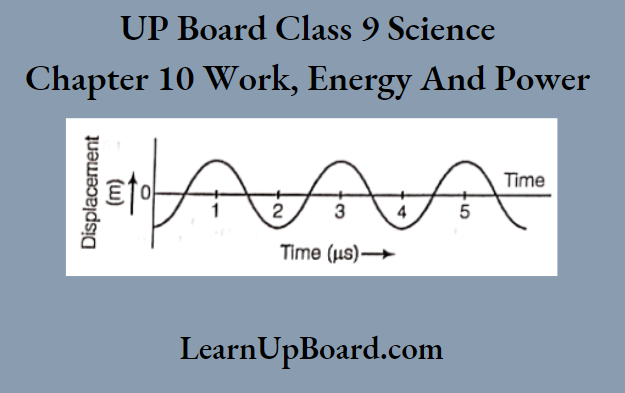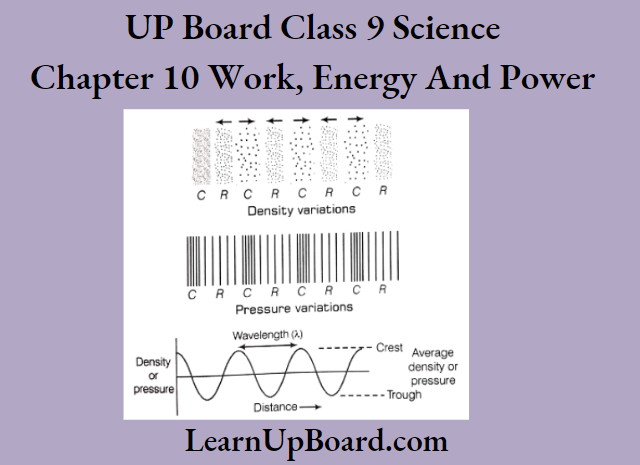UP Board Solutions For Class 9 Science Chapter 10 Work, Energy And Power Very Short Answer Type Questions
Question 1. What is the work done when you apply an ION force on a wall?
Answer:
Zero work because there is no displacement of the wall.
Question 2. Why do we say work done against gravity is negative?
Answer:
It is because force and displacement are in opposite directions to each other.
Question 3. A man is holding a suitcase in his hand at rest. What is the work done by him?
Answer:
Zero, as displacement is zero.
Question 4. A boy is running along a circular path at a uniform speed. What is the work done by the boy?
Answer:
Work done by the boy is zero because the angle between the force (centripetal) and displacement in case of circular motion is 90°.
Question 5. Think of two situations for each of the following given conditions.
- Large mass but low kinetic energy.
- Small mass but high kinetic energy.
Answer:
- A shot put thrown by an athlete.
- A hockey ball which has been hit hard by a player and is travelling fast.
Read and Learn More Class 9 Science Solutions
Question 6. What will cause greater change in kinetic energy of a body? Changing its mass or changing its velocity.
Answer:
Change in velocity will cause greater change in kinetic energy because KE = 1/2 mv2
Question 7. Name the type of energy stored in spring of a watch.
Answer:
Type of energy stored in spring of a watch
Elastic potential energy is stored in spring of a watch.
Question 8. In which situation, the potential energy of a spring be minimum?
Answer:
When a spring is at its natural length (i.e. neither stretched nor compressed), the potential energy of a spring will be minimum.
Question 9. If a body is thrown vertically upwards, its velocity goes on decreasing. What happens to its kinetic energy when it stops at the top and its velocity becomes zero?
Answer:
The whole of its kinetic energy gets converted into potential energy (mgh), where m is the mass of body and h is the height and g is the acceleration due to gravity.
Question 10. Can any object have mechanical energy even, if its momentum is zero?
Answer:
- Since, mechanical energy is the sum of kinetic energy and potential energy. And as given that, momentum of the body is zero, it means velocity of the body is zero, so it has kinetic energy equals to zero.
- But it may have potential energy. So, even if the momentum of the body is zero, it may have mechanical energy.
Question 11. The head of a nail becomes hot when it is hammered into a plank of wood. What energy transformation takes place in this case?
Answer:
Kinetic energy of falling hammer is converted into heat energy when it strikes the head of a nail. Therefore, the head of a nail becomes hot.
Question 12. A car and a truck have the same speed of 60 ms”1. If their masses are in the ratio 1:4. Find the ratio of their KE.
Answer:
As, \(\frac{\mathrm{KE}_1}{\mathrm{KE}_2}=\frac{1 / 2 m_2 v^2}{1 / 2 m_2 v^2}=\frac{m_1}{m_2}=\frac{1}{4}\)=1: 4
Question 13. If a speed of a particle is doubled, what will be the ratio of its kinetic energy to its momentum?
Answer:
Kinetic energy, \(\mathrm{KE}^{\prime} =\frac{1}{2} m\left(v^{\prime}\right)^2 [v^{\prime}=2 v]\)
= \(\frac{1}{2} m(2 v)^2=4 \mathrm{KE}\)
and momentum, \(p^{\prime =m v^{\prime}}\)
= \(m(2 v)=2 p [ v^{\prime}=2 v]\)
⇒ \(\frac{\mathrm{KE}^{\prime}}{p^{\prime}} =\frac{4 \mathrm{KE}}{2 p}=2 \times\left(\frac{\mathrm{KE}}{p}\right)\)
Hence, ratio gets doubled.
Question 14. If a 5 kg mass is raised to a height of 2 m, calculate the work done against the force of gravity. (Given, g = 9.8 ms-2)
Answer:
Given, mass, m= 5 kg,
height, h = 2m, W =?
We know that work, W = mgh = 5 x 9.8 x 2 = 98 J
Question 15. A ball is dropped from a height of 10 m. If the energy of the ball reduces by 40% after striking the ground, how much high can the ball bounce back? (Take, g=10m-2)
Answer:
Given
A ball is dropped from a height of 10 m. If the energy of the ball reduces by 40% after striking the ground
If the energy of the ball reduces by 40% after striking the ground, then remaining energy of the ball will be 60% of initial energy.
Let initial energy of the body of mass (m) at height (h) is (mgh).
According to the question,
mgh’ = 60% of mgh [given, h =10 m and g =10 ms-2]
∴ \(h^{\prime}=60 \% \times h=\frac{60}{100} \times 10=6 \mathrm{~m}\)
Question 16. An object of mass 2 kg is dropped from a height of lm. What will be its kinetic energy as it reaches the ground? (Take, g =9.8 ms-2)
Answer:
Given, mass, m = 2 kg and height, h =1 m.
On reaching the ground, the kinetic energy of object is converted into its potential energy such that KE= YE-mgh = 2 x 9.8 x 1 = 19.6 J
Question 17. A girl weighing 50 kg runs up a hill raising herself vertically 10 m in 20 s. What is the power expended by girl?
Answer:
Power expended by girl =\(\frac{\text { Work doac by girl }}{\text { Time raken }}\)
= \(\frac{F \times s}{t}=\frac{m g \times s}{t}\)
= \(\frac{50 \times 9.8 \times 10}{20}\)
= 245 W[ F=m g]
UP Board Solutions For Class 9 Science Chapter 10 Work, Energy And Power Short Answer Type Questions
Question 1. Is it possible that an object is in the state of accelerated motion due to external force acting on it, but no work is being done by the force? Explain it with an example.
Answer:
Yes, when a force acts in a direction perpendicular to the direction of displacement e.g. Earth revolves around the Sun under the gravitational force of Sun on Earth, but no work is done by the Sun, though Earth has a centripetal acceleration
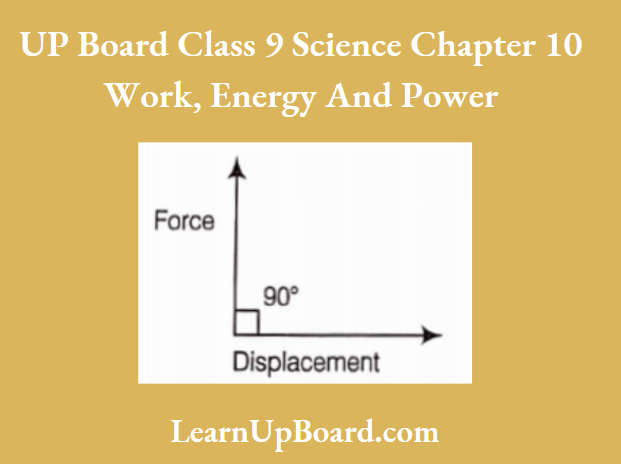
Question 2. At the bottom of the waterfall, the water is warmer than at the top. Give reason.
Answer:
When water falls on the ground, its mechanical energy (KE + PE) is converted into heat energy, due to which the temperature of water at the bottom of the waterfall increases.
Question 3. What is meant by the transformation of energy? Explain with the help of two suitable examples.
Answer:
Transformation of energy
One form of energy can be converted into other forms of energy, this phenomenon is called transformation of energy.
- When we throw a ball, muscular energy which is stored in our body, gets converted into the kinetic energy of the ball.
- The wound spring in the toy car possesses potential energy. As the spring is released, its potential energy changes into kinetic energy due to which, the toy car moves.
Question 4. A light and a heavy object have the same momentum. Find out the ratio of their kinetic energies. Which one has a larger kinetic energy?
Answer:
Given
A light and a heavy object have the same momentum.
Suppose m1 and m2 are masses of light and heavy objects, respectively. As we know,
kinetic energy, K=\(\frac{1}{2} m v^2\) [where, y= velocity of objects.] …(1)
and momentum, p = mv
On multiplying and dividing with m in Eq. (1), we get
So, K=\(\frac{1}{2} \frac{m v^2 \times m}{m}\)
K=\(\frac{1}{2} \frac{(m v)^2}{m}\) as from Eq. (2) [ p=m v]
So, K=\(\frac{p^2}{2 m}\)
We have, kinetic energy, K=\(\frac{p^2}{2 m}\)
Momentum is the same for light and heavy bodies.
So, kinetic enetgy, K \(\propto \frac{1}{m}\)
Thus, kinetic energy is inversely proportional to the mass.
So, a lighter body has larger kinetic energy.
Question 5. When a force retards the motion of a body, what is the nature of work done by force? State reason. List two examples of such a situation.
Answer:
The nature of work done in the case of retarding motion is negative.
Suppose a force F brings a body moving with velocity v to rest (retards), then work done
= change in KE
=\(\mathrm{KE}_f-\mathrm{KE}_i\)
W =\(0-\frac{1}{2} m x^2=-\frac{1}{2} m s^2\)
For Example
When we apply the brakes of a car, the work done is negative.
Work done by frictional force is negative.
Question 6. A car is moving on a levelled road and gets its velocity doubled. In this process,
- how would the potential energy of the car change?
- how would the kinetic energy of the car change?
Answer:
- The potential energy of the car remains the same, since PE (= mgh) is independent of velocity.
- The kinetic energy of the car becomes four times since KE \(\left(=\frac{1}{2} m \nu^2\right)\) is proportional to the square of velocity.
Question 7. A girl sits and stands repeatedly for 6 min. Draw a graph to show the variation of the potential energy of her body with time.
Answer:
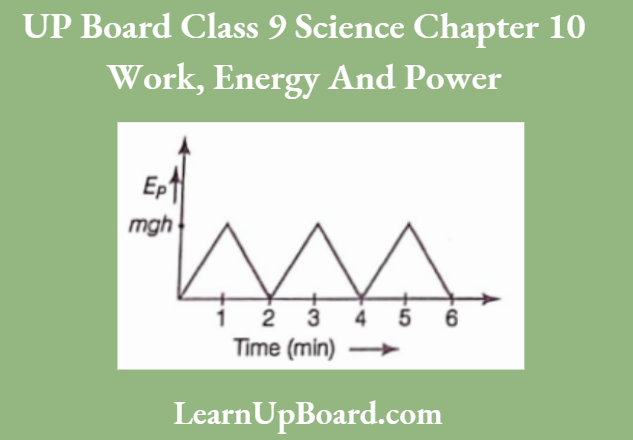
- From the graph shown above, we can take the sitting position of the girl as the position of zero potential energy.
- Let m be the mass of the girl and h be the position of the centre of gravity while standing above the sitting position.
- The PE while standing is + mgh and while sitting is zero. We can assume that there is no acceleration or deceleration while standing and sitting, this is repeated after every minute.
Question 8. (1) The potential energy of a freely falling object decreases progressively. What happens to its
- kinetic energy,
- total mechanical energy?
State the law on which your answer is based.
(2) A household consumes 1 kWh of energy per day How much energy is this in joules?
Answer:
(1) (1) As potential energy decreases with decreasing height, the speed of the object will increase and hence its kinetic energy will increase.
(2) Total mechanical energy will remain constant. It is based on the law of conservation of energy which states that energy can neither be created nor be destroyed. It can only be transformed from one form to another.
(2) 1 kWh = 3.6xl0 6J
Question 9. If a body falls from a height bounces from the ground and again goes upwards with the loss of a part of its energy.
- How will its potential energy change?
- What are various energy conversions taking place?
Answer:
- When it strikes the ground, its PE is zero and after bouncing, its potential energy increases gradually.
- At the time it strikes the ground, it has maximum KE and after it bounces, its KE starts changing into potential energy.
Question 10. Why do we say that a lift delivers more power in taking a man up than that delivered by a man climbing stairs through the same height?
Answer:
It is true to say that a lift delivers more power in taking a man up than that delivered by him climbing the stairs at the same height. It is because, a lift takes less time in taking the man up, so it delivers more power.
Question 11. When an arrow is shot, from where does the arrow acquire its kinetic energy?
Answer:
A stretched bow has potential energy due to the change in its shape. To shoot the arrow, the bow has to be released.
Therefore, its potential energy is converted into the kinetic energy of the arrow.
Question 12. Seema tried to push a heavy rock of 100 kg for 200 seconds but could not move it. Find the work done by Seema at the end of 200 s.
Answer:
The work done by Seema in pushing a rock for 200 s is zero. Because there is no displacement in this case, i.e. W = Fx s =0 [v s =0]
Question 13. A coolie lifts a box of 15 kg from the ground to a height of 2 m. Calculate the work done by coolie on the box. (Given, g = 9.8 ms-2)
Answer:
Given,
A coolie lifts a box of 15 kg from the ground to a height of 2 m
mass, m = 15 kg, distance, s =2m, g =9.8 ms-2, W=>
Now, force applied,
F=mg= 15 x 9.8 = 147 N
Work done, W = F x s = 147 x 2 = 294 N
Question 14. How is work done by a force measured? A porter lifts luggage of 20 kg from the ground and puts it on his head 1.7 m above the ground. Find the work done by the porter on the luggage. (Take, g = 10 ms-2 )
Answer:
Work done by a force is measured by the product of force and displacement when they are in the same direction or opposite direction.
Given, m = 20 kg
s =1.7 m [where, m = mass of luggage, g = acceleration due to gravity.]
W = Fs = mgs [ Fand s arc in the same direction.]
= 20x 10x 1.7= 340 J
Question 15. A boy is moving on a straight road against a frictional force of 5 N.
After travelling a distance of 1.5 km, he forgot the correct path at a roundabout of a radius of 100 m as shown in the figure.
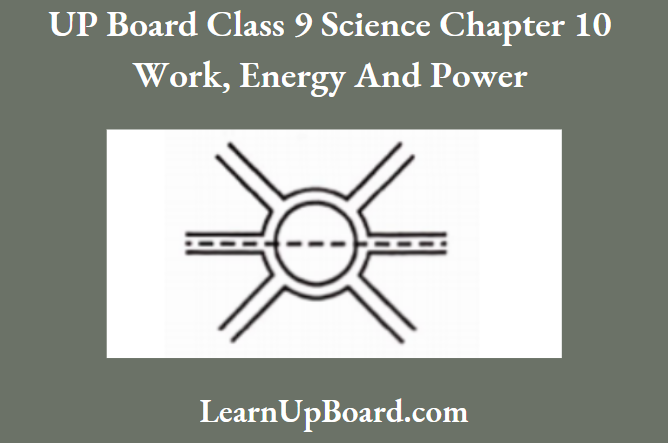
However, he moves on the circular path for one and a half cycles and then he moves forward up to 2 km. Calculate the work done by him.
Answer:
Given, the force applied by the boy against friction = 5 N
Displacement on the circular path
= One cycle + Half cycle
= 0 + Half cycle
= 0 + Diameter of circular path [ Displacement depends on initial and final point]
= 0 + 2 r =0 + 2 x 100 [given, r =100 m]
= 0 + 200 =200 m
Total displacement = 1.5 km+ 200 m+ 2 km
= 1.5 x 1000 +200+ 2x 1000 m [1km = 1000 m]
= 3700 m
Work done by boy = Fs
= 5 x 3700 =18500J
Question 16. A bus and a car have the same KE. Which of the two is moving fast? Explain.
Answer:
The KE is given by KE=\(\frac{1}{2} m v^2 \Rightarrow v=\sqrt{\frac{2 \mathrm{KE}}{m}}\) As KE of both bus and car is same, so v \(\propto \frac{1}{\sqrt{m}}\)
Since the mass of the car is less than that of the bus, the car moves faster than the bus.
Question 17. Compute the speed of a 2 kg ball having a kinetic energy of 4 J.
Answer:
Given, the mass of the ball, m = 2 kg
The kinetic energy of the ball, KE = 4 J
As, KE =\(\frac{1}{2} m v^2\)
⇒ \(v^2=\frac{2 \mathrm{KE}}{m}=\frac{2 \times 4}{2}=4\)
v=2 \(\mathrm{~ms}^{-1}\)
Question 18. A car and a truck have the same speed of 30 ms-1. If their masses are in the ratio of 1:3, find the ratio of their kinetic energies.
Answer:
Given, \(v_1=v_2=30 \mathrm{~ms}^{-1}\)
According to question, \(\frac{m_1}{m_2}=\frac{1}{3}\)
⇒ \(\frac{\mathrm{KE} \text { of car }}{\mathrm{KE} \text { of truck }}=\frac{\frac{1}{2} m_1 v_1^2}{\frac{1}{2} m_2 v_2^2}=\left(\frac{m_1}{m_2}\right)=\frac{1}{3}\)
Question 19. If two bodies have masses in the ratio 1: 8 and have their speed in the ratio 4:5, find the ratio of their KE.
Answer:
Given, \(m_1 / m_2=1: 8, and v_1 / v_2=4: 5\)
⇒ \(\frac{\mathrm{KE}_1}{\mathrm{KE}_2} =\frac{1 / 2 m_1 v_2^2}{1 / 2 m_2v_2^2}=\frac{m_2}{m_2}\left(\frac{v_1}{v_2}\right)^2\)
= \(\frac{1}{8} \times\left(\frac{4}{5}\right)^2\)
= \(\frac{1}{8} \times \frac{16}{25}=\frac{2}{25}=2: 25\)
Question 20. A rocket is moving up with a velocity v. If the velocity of this rocket is suddenly tripled, what will be the ratio of the two kinetic energies?
Answer:
Given, \(v_1=v\) and \(v_2=3 v\)
Kinetic energy of rocket, K=\(\frac{1}{2} m v^2\)
The ratio of two kinetic energies,
⇒ \(\frac{K_1}{K_2}=\frac{\frac{1}{2} m v_1^2}{\frac{1}{2} m v_2^2}\)
⇒ \(\frac{K_1}{K_2}=\frac{v_1^2}{v_2^2} \quad\left[\text { put } v_2=3 v \text { and } v_1=v\right ]\)
We get =\(\frac{v^2}{(3 v)^2}=\frac{v^2}{9 v^2}=\frac{1}{9} \Rightarrow \frac{K_1}{K_2}=\frac{1}{9}\)
Thus, the ratio of two kinetic energies \(K_1: K_2=1: 9\)
Question 21. A child drops a stone of 1 kg from the top of a tower. Find its kinetic energy, 5 s after it starts falling. (Take, g = 10 ms-2)
Answer:
Given, the mass of the stone, m = 1 kg
Initial velocity, u =0, time, t = 5 s Acceleration due to gravity, g = 10 ms-2
As from the equation of motion.
r=\(N+s^t\) [for downward motion]
r=0+10 x 5
r=50 \(\mathrm{~ms}^{-1}\) [for downward motion]
The kinetic energy of the stone is given by
⇒ \(\frac{1}{2} m v^2=\frac{1}{2} \times 1 \times(50)^2=1250 \mathrm{~J}\)
Question 22. A mass of 20 kg is dropped from a height of 0.5 m. Find its (1) velocity and
(2) KE as it just reaches the ground.
Answer:
Given, height, h=0.5 m, mass, m=20 kg
(1) \(p^2=2 g h=2 \times 10 \times\) 0.5=10
⇒ \({\left[ g=10 \mathrm{~ms}^{-2}\right]}\)
∴ \(\nu=\sqrt{10}=3.16 \mathrm{~ms}^{-1}\)
(2) We know that, KE =\(\frac{1}{2} m \nu^2\)
= \(\frac{1}{2} \times 20 \times 10=100 \mathrm{~J}\)
Question 23. What is the amount of work done in the following cases? Justify your answer by giving the appropriate reason.
- By an electron revolving in a circular orbit of radius r around a nucleus.
- By the force of gravity, when a stone of mass m is dropped from the top of a multi-storeyed building of height h.
Answer:
(1) Work done is zero as shown in the figure below.
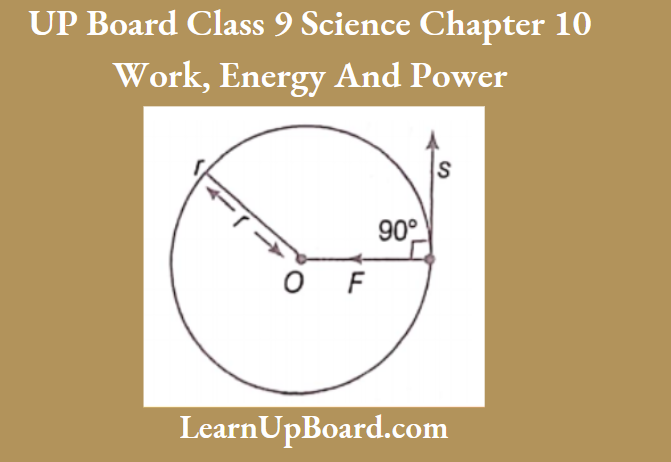
When an electron revolves around the nucleus, a centripetal force F acts along the radius towards the centre O.
The displacement (s) acts tangentially, therefore the angle between the force and the displacement is 90°. Therefore, W= 0
(2) We know that, W = mgh
As the stone is dropped, its PE starts to convert into KE.
Let its speed be v, then from \(v^2\)=2 g h (when stone reaches the ground)
KE =\(\frac{1}{2} m v^2\)
= \(\frac{1}{2} \times m \times 2 g h=m g h \Rightarrow W\) = mgh
Question 24. A boy lifts a suitcase of 20 kg from the ground to a height of 1.2 m. Calculate the work done by him on the suitcase. (Given, g=10ms-2)
Answer:
Given, mass, m = 20 kg, height, h = 1.2 m, g =10 ms-2
Work done, W = mgh = 20 x 10 x 1.2 = 240 J
Question 25. A shotput player throws a shotput of mass 3 kg. If it crosses the top of the wall 2 m high at a speed of 4 ms-1. Compute the total mechanical energy gained by the shotput when it crosses the wall.(Given, g =9.8 \(\mathrm{~ms}^{-2}\))
Answer:
Given, m=3 \(\mathrm{~kg}, h=2 \mathrm{~m}, y=4 \mathrm{~ms}^{-1}, g=9.8 \mathrm{~ms}^{-2}\)
Total mechanical energy =\(\mathrm{KE}+\mathrm{PE}=\frac{1}{2} m v^2+m g h\)
= \(\frac{1}{2} \times 3 \times 16+3 \times 9.8 \times 2\)
= 24+58.8=82.8 J
Question 26. Avinash can run with a speed of 8 ms-1 against the frictional force of 10 N and Kapil can move with a speed of 3 ms-1 against the frictional force of 25 N. Who is more powerful and why?
Answer:
Given, the force applied by Avinash = 10 N
Speed of Avinash = 8 m s-1
Power of Avinash =F. v =10 x 8 =80 W
Now, force applied by Kapil = 25 N
Speed of Kapil = 3 m s-1
Power of Kapil = F . v
= 25 x 3 = 75 W
Since, Avinash has more power (80 – 75), i.e. 5 W than Kapil. So, Avinash is more powerful.
Question 27. The human heart does 1.5 J of work in every beat. How many times per minute does it beat, if its power is 2 W?
Answer:
Given, power, P=2 W, time, t=1 min =60 s
Total work, W=\(P_t \quad\left[ P=\frac{W}{t}\right]\)
=2 x 60 s=120J
1.5 J work is done in 1 beat.
120 J work will be done in \(\frac{1 \times 120}{15}\)=80 beats
Therefore, number of beats per min = 80
Question 28. For an experiment to measure his power, a student records the time taken by him to run up a flight of steps on a staircase. Use the following data to calculate the power of the student.
Number of steps =28
Height of each step =20 cm
Time taken =5.4 s
Mass of student =55 kg
Acceleration due to gravity =9.8 \(\mathrm{~ms}^{-2}\)
Answer:
Given. n=28, b =20 cm =0.2 m, t=5.4 s
m =55 kg, g=9.8 \(\mathrm{~ms}^{-2}\)
We know that the power of student is given by
P =n \(\times \frac{W}{r}=n \times \frac{m g b}{t}\)
= \(\frac{28 \times 55 \times 9.8 \times 0.2}{5.4}\) [ W = mgh]
=559 W
Question 29. A boy X can run with a speed of 8 ms-1 against the frictional force of 10 N and another can move with a speed of 3 ms-1 against the frictional force of 20 N. Find the ratio of powers of X and Y.
Answer:
Given, the distance travelled by the boy X in 1 s = 8 m Distance travelled by the boy Fin ls=3m
As we know, work done by the boy X to run against the frictional force of 10 N = 10 Nx 8 m= 80 J
So, power of 80 J of work done by X=\(\frac{W}{t}=\frac{80 \mathrm{~J}}{1 \mathrm{~s}}\)
=80 W
Similarly, work done by the boy Y to run against the frictional force of 20 \(\mathrm{~N}=20 \mathrm{~N} \times 3 \mathrm{~m}=60 \mathrm{~J}\)
Power of Y=\(\frac{60 \mathrm{~J}}{1 \mathrm{~s}}=60 \mathrm{~W}\)
So, the ratio of two values of powers is given by
∴ \(\frac{\text { Power of } X}{\text { Power of } Y}=\frac{80}{60}=\frac{4}{3}=4: 3\)
Question 30. The power of a motor pump is 60 W. Find the mass of water, the pump can lift per minute from a 10 m deep well. (Take, g =10 ms-2)
Answer:
Given, power, P = 60 W, time, t = 60 s Height, h =10m
The energy supplied to the pump = Power x Time
= 60 W x 1 min [vlmin=60s]
= 60 Wx 60s
= 3600 Ws= 3600J
So, energy, E = mgb
3600 = mx 10×10
m = 36 kg
So, the mass of the water is 36 kg.
Question 31.
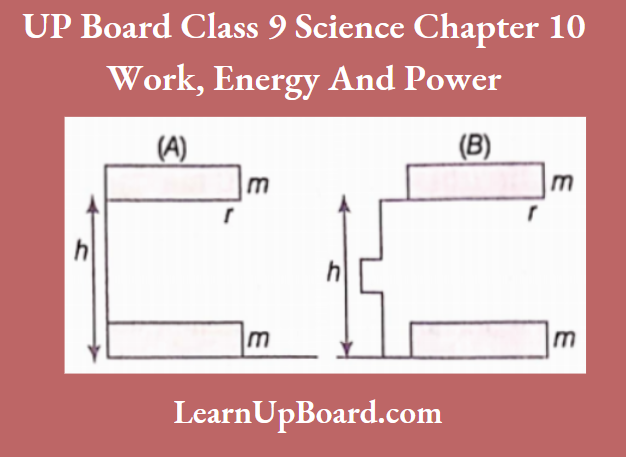
- What is meant by the potential energy of a body?
- A body of mass m is raised to a vertical height of h through two different paths A and B.
What will be the potential energy of the body in the two cases? Give a reason for your answer.
Answer:
- The energy possessed due to the position of a body is called potential energy.
- The work done against gravity in both cases is mgh. It is independent of the path along which the body is moved and it depends only on the initial and final positions of the body.
Question 32. At a height of 20 m above the ground, an object of mass 4 kg is released from rest. It is travelling at a speed of 20 ms-1 when it hits the ground. The object does not rebound and the gravitational field strength is 10Nkg-1.
How much energy is converted into heat and sound on impact?
Answer:
Given, height above the ground, b = 20 m Mass of the ball, m = 4 kg
Speed of the ball while striking the ground, v =20 ms-1
Acceleration due to gravity,
g =10 Nkg-1
According to the law of conservation of energy, all the energy of the ball will be converted into sound and heat energy because the ball does not rebound.
Energy of the ball =\(\frac{1}{2} m v^2\)
=\(\frac{1}{2} \times 4 \times(20)^2=800 \mathrm{~J}\)
Hence, 800 J of energy will be converted into heat and sound.
Question 33. A labourer whose own mass is 50 kg carries a load of an additional 60 kg on his head to the top of a building 15 m high. Find the total work done by him. Also, find the work done by him, if he carries another additional block of mass 10 kg to the same height. (Take, g =10 ms-1)
Answer:
Given, total mass, m =50 + 60 =110 kg
Displacement, s =15 m
Work done by him is given by W =0 [since force and displacement are perpendicular to each other.]
If an additional block of mass 10 kg is carried by him to the same height, then also work done by him remains zero because force and displacement are perpendicular to each other.
Question 34. A girl with a mass of 35 kg sits on a trolley of mass 5 kg. The trolley is given an initial velocity of 4 ms-1 by applying a force.
The trolley comes to rest after traversing a distance of 16 m.
- How much work is done on the trolley?
- How much work is done by the girl?
To find the value of acceleration (a) by using the third equation of motion, i.e. v² = u² + 2as and then putting this value in W =mass to get the required work.
Answer:
Given, w = 4 ms-1,v =0 and 5 =16 m From the third equation of motion,[for retardation, the acceleration is negative, i.e. a=-a]
⇒ \(v^2=u^2-2 a \Rightarrow(0)^2=(4)^2-2 a \times 16\)
0=16-32 a \(\Rightarrow a=\frac{16}{32}=0.5 \mathrm{~ms}^{-2}\)
where, u = initial velocity, v = final velocity, a = acceleration and s = displacement.
(1) Total mass = 35 + 5 = 40 kg
Work is done on the trolley,
W = F-d =ma s [v F =ma]
= 40×0.5×16 =320 J
(2) Given, the mass of the girl, m =35 kg
Work done by the girl,
W =F-d =ma r = 35×0.5×16 = 280]
Question 35. Calculate the kinetic energy of a car of mass 750 kg moving with a velocity of 54 km. Find the new kinetic energy of the car, if a passenger of mass 50 kg sits in the car.
Answer:
Given, mass, m=750 kg, velocity, v=54 \(\mathrm{kmh}^{-1}\)
=54 \(\times \frac{5}{18} \mathrm{~ms}^{-1}=15 \mathrm{~ms}^{-1}\)
Kinetic energy, \(\mathrm{KE}=\frac{1}{2} m v^2\)
KE =\(\frac{1}{2} \times 750 \times(15)^2=84375 \mathrm{~J}\)
If a passenger of mass 50 kg sits in the car, then total mass becomes (750+50) kg, i.e. 800 kg
New KE =\(\frac{1}{2} \times 800 \times(15)^2=90000 J\)
Question 36. On a level road, a scooterist applies brakes to slow down from a speed of 54 kmh-1 to 36 kmh-1. What amount of work is done by the brakes? (Assuming the mass of the empty scooter is 86 kg and that of the scooterist and petrol is 64 kg.)
Answer:
Here, total mass, w = 86 + 64 = 150 kg
Initial velocity, u=54 \(\mathrm{kmh}^{-1}\)
=\(\frac{54 \times 1000}{3600}=15 \mathrm{~ms}^{-1}\)
Final velocity, v=36 \(\mathrm{kmh}^{-1}\)
=36 \(\times \frac{1000}{3600}=10 \mathrm{~ms}^{-1}\)
Work done by brakes = KE lost by the scooter
= Final KE – Initial KE
=\(\frac{1}{2} m v^2-\frac{1}{2} m u^2=\frac{1}{2} m\left(v^2-u^2\right)\)
=\(\frac{1}{2} \times 150\left[(10)^2-(15)^2\right]=\frac{1}{2} \times 150(100-225)\)
= -75×125 = -9375 J
Question 37. (1) Define potential energy.
(2) Give an example where potential energy is acquired by a body due to a 75 m change in its shape
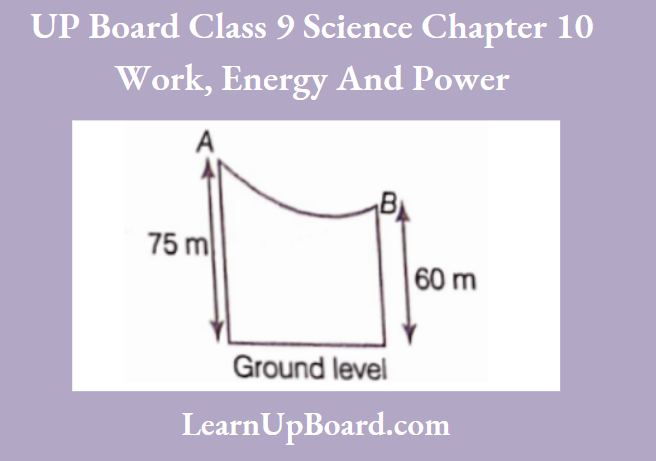
(3) A skier of mass 50 kg stands at A, at the top of a ski jump. He takes off from A for his jump to B. Calculate the change in his gravitational potential energy between A and B.
Answer:
(1) Potential Energy It is the energy possessed by a body by virtue of its position or shape.
(2) In a toy car, the wound spring possesses potential energy. When spring is released, its potential energy changes into kinetic energy due to which the toy car moves.
(3) Given, m=50 \(\mathrm{~kg} . h=75 \mathrm{~m}_1 h_2=60 \mathrm{~m}\)
At point A, \(\mathrm{PE}_1=m g h_h=50 \times 10 \times 75\)
=37500 J
At point B, \(\mathrm{PE}_2=m g h_2=50 \times 10 \times 60\)
=30000 J
Change in PE =\(\mathrm{PE}_1-\mathrm{PE}_2\)=37500-30000 =7500 J
Question 38. A body of mass 5 kg is thrown vertically upwards with an initial velocity of 50 ms-1. What will be its potential energy at the end of 5 seconds?
Answer:
Given, m=5 \(\mathrm{~kg}, w=50 \mathrm{~ms}^{-1}, t=5 \mathrm{~h} g=-10 \mathrm{~ms}^{-2}\)
Height covered by the body in 5 s is h=w t+\(\frac{1}{2} g t^2\)
50 \(\times 5-\frac{1}{2} \times 10 \times(5)^2\)
=250-125=125 m
Therefore, PE of the body after 5 s
= mgh =5 x 10 x 125 = 6250 J
Question 39. A body of mass 1.5 kg is thrown vertically upwards with an initial velocity of 15 ms-1. What will be its potential energy at the end of 2 s? (Take, g =10 ms-2)
Answer:
Given, mass, m = 1.5 kg
Initial velocity, u =15 ms-1
Time, t = 2s
From Newton’s second equation of motion,
t=w t+\(\frac{1}{2} g t^2\)
s=15 \(\times 2+\frac{1}{2} \times 10 \times 4=50 \mathrm{~m}\)
Potential energy, PE = mgh
=1.5 \(\times 10 \times 50\) [ b=t]
=750 J
Question 40. Four men lift a 250 kg box to a height of 1 m and hold it without raising or lowering it.
- How much work is done by the man in lifting the box?
- How much work do they do in just holding it?
- Why do they get tired while holding it? (Given, g = 10 ms-2)
Answer:
- Given, mass, m = 250 kg, height, A = lm and acceleration due to gravity, g =10 m s-2
- Work done by the man in lifting the box W = Potential energy of box W = mgh = 250 x 10 x 1 = 2500 J (it) Work done is zero in holding a box because displacement is zero.
- In holding the box, the energy of each man is lost. Due to loss of energy, they felt tired.
Question 41. The weight of a person on planet A is about half that on the Earth. He can jump up to 0.4 m height on the surface of the Earth. How high can he jump on planet A?
Answer:
Given
The weight of a person on planet A is about half that on the Earth. He can jump up to 0.4 m height on the surface of the Earth.
It is given that the weight of a person on the Earth = w (i .e.w =mg)
And as he can jump up to height (hy) = 0.4 m So, potential energy at this point
= mgh = mgh x 0.4 → Equation .(1)
And it is given that
weight of the person on the other planet = \(\frac{w}{2}\) → Equation 2
And if he could jump to height \(\left(b_2\right)\) its potential energy would be \(\frac{w}{2} h_2=\frac{m g}{2} b_2\)
Since he applied the same amount of effort in both cases to lift his body, its potential energy will be the same.
From Eqs. (1) and (2), we get
m g \(\times 0.4=\frac{m g}{2} b_2 \Rightarrow b_2=0.4 \times 2=0.8 \mathrm{~m}\)
Question 42. 300 J of work is to be done in lifting a bag of mass 5 kg in weight up to a height of 4 m from the ground. What will be the acceleration with which the bag was revised? (Take, g = 10 ms-2)
Answer:
Given,
300 J of work is to be done in lifting a bag of mass 5 kg in weight up to a height of 4 m from the ground.
mass, m=5 kg, work, W=300 J
h=4 \(\mathrm{~m}, g=10 \mathrm{~ms}{ }^{-2}\)
Work done, W=m g h+m a b=m(g+a) b
300=5 \(\times(10+a) \times 4\)
300=20(10+a)
10+a=\(\frac{300}{20}\)=15
a=15-10=5 \(\mathrm{~ms}^{-2}\)
Question 43. Shyam drops a ball of 100 g from a building of a height of 10 m. What will be its kinetic energy at the height of 4 m? What will happen to its total mechanical energy? Give reasons to justify your answer.
Answer:
Given, mass, m = 100 g = 0.1 kg, height, A = 10m
Potential energy, PE = mgh = 0.1x10x10 = 10 J [v g =10 ms-2]
When the body reaches a height of 6 m, its velocity is given by
⇒ \(r^2=s^2+2 s^h\)
⇒ \(r^2=0^2+2 \times 10 \times 6\) [h=10-4 or h=6]
v=\(\sqrt{2 \times 10 \times 6}=2 \sqrt{30}\)
Now, its kinetic energy at this point is given by
=\(\frac{1}{2} m r^2=\frac{1}{2} \times 0.1 \times 4 \times 30=6 \mathrm{~J}\)
As, mechanical energy = KE + PE [at highest point] Mechanical energy = (0 + 10)J=10J Mechanical energy at 4 m height
= KE+PE = 6+0.1 x 10x 4= 10]
Hence, it is seen that total mechanical energy always remains constant during the motion.
Question 44. A mass of 10 kg is dropped from a height of 50 cm. Find its
- potential energy just before dropping.
- kinetic energy just touching the ground.
- the velocity with which it hits the ground (Take, g = 10 ms-2)
Answer:
Given, mass of the object, m= 10 kg Height, h =50 cm= 0.3 m
(1) As potential energy is given by PE = mgh =10 x 10 x 0.5 = 50]
(2) From the law of conservation of energy,
the total energy of the ball just before dropping =total energy of the ball just on touching the ground KE + PE of the ball just before dropping
= KE of the ball just on touching the ground => KE = 50J
(3) As we know, KE = 50 J
So, \(\frac{1}{2} m v^2=50 \Rightarrow v^2=\frac{50 \times 2}{10}=10\)
So, the velocity with which it hits the ground,
∴ \(\mathrm{v}=\sqrt{10}=3.16 \mathrm{~ms}^{-1}\)
Question 45. A small child tends to mimic his father by lifting a mass of 10 kg on his head. As soon as he succeeds in lifting it, he loses the object and falls back to the ground. If the child has a height of 90 cm, find the kinetic energy
- At half the height of the child,
- With which the object strikes the ground.
Answer:
Given, the mass of the object, m =10 kg Height of the child, h- 90 cm = 0.9 m Total energy of the object at the head of the child is given by
= PE+ KE = mgh + 0 [v KE=0, asrr =0] = mgh= lOx 9.8x 0.9= 88.2 J
(1) At half the height of the child, i.e. at 0.45 m
Total energy, TK = PK + KE = mgh + KE
= 10 x 9.8 x 0.45+ KE
Now, from the law of conservation of energy,
KE+ 10x 9.8x 0.45= 88.2 or KE+ 44.1 = 88.2
KE= 88.2-44.1 =44.1 J
(2) When the object strikes the ground,
Total energy = PE + KE = 0 + KE
= KE [PE = 0, as h =0]
From the law of conservation of energy,
KE= 88.2 J [v TE =88.2 J]
Question 46. (1) State and define the SI unit of power.
(2) A person carrying 10 bricks each of mass 2.5 kg on his head moves to a height 20 m in 50 s. Calculate the power spent in carrying the bricks of the person. (Given, g =10 ms-2)
Answer:
(1) The SI unit of power is watt.
1 watt is the power of a body which does work at the rate of 1 joule per second.
wart =\(\frac{1 \text { Joule }}{1 \text { Second }}\)
(2) Given, the mass of one brick = 2.5 kg
Mass of 10 bricks = 2.5 x 10 = 25 kg
Height, h = 20 m, time, t = 50 s, power, P = ?
Power P =\(\frac{m g h}{t}\)
= \(\frac{25 \times 10 \times 20}{50}=100 \mathrm{Js}^{-1}\)
Question 47. Mohan lifts his cell phone to a height of 1 m. He takes Is to do this. After lowering the phone, he then lifts it 2 m in 2 s. Has he generated more power in doing the second task? Give a reason to justify your answer.
Answer:
Given
Mohan lifts his cell phone to a height of 1 m. He takes Is to do this. After lowering the phone, he then lifts it 2 m in 2 s.
Let, the mass of cellphone be m kg
Work done (W) by Mohan = mgh
where, h = height at which the cellphone is raised and
g = acceleration due to gravity
W = mg x 1 = mg
Power delivered (R)=\(\frac{\text { Work done }(W)}{\text { Time }(T)}\)
=\(\frac{m g}{1}=m g\)
Work done to lift cell phone by 2 m
= mg x 2 = 2 mg
Power delivered \(\left(R_2\right)=\frac{\text { Work done (IV) }}{\text { Tine (T) }}\)
=\(\frac{2 m g}{2}\)=m g
So in both cases, the power delivered by Mohan is the same.
Question 48. A force applied on a body of mass 4 kg for 5 s changes its velocity from 10 \(\mathrm{~ms}^{-1}\) to 20 \(\mathrm{ms}^{-1}\). Find the power required.
Answer:
Given, m=4 kg, t=5 s, w=10 \(ms^{-1}\),
v=\(20 \mathrm{~ms}^{-1}\), P=?
Power, \(P=\frac{W}{t}=\frac{\text { Change in } \mathrm{KE}}{\text { Time taken }}\)
P =\(\frac{1}{2} \times \frac{m\left(v^2-u^2\right)}{t}=\frac{1}{2} \times \frac{4\left\{(20)^2-(10)^2\right]}{5}\)
=\(\frac{1}{2} \times \frac{4 \times 300}{5}=120 \mathrm{Js}{ }^{-1}\)
Question 49. A boy of mass 50 kg runs up a staircase of 45 steps in 9 seconds. If the height of each step of the staircase is 15 cm, find the power of the boy. (Given, g=10 \(\mathrm{~ms}^{-2}\) )
Answer:
Given, the mass of the body, m=50 kg
b=45 \(\times 15=675 \mathrm{~cm}=6.75 \mathrm{~m}\)
t=9 \(\mathrm{~s}, g=10 \mathrm{~ms}^{-2}\)
PE =m g b=50 \(\times 10 \times 6.75=3375 \mathrm{~J}\)
So, the energy of the boy is 3375 J.
Power of the boy,
y, P =\(\frac{\mathrm{PE}}{\text { Time }}=\frac{\text { Energy }}{\text { Time }}\)
=\(\frac{3375}{9}=375 \mathrm{~W}\)
Question 50. A machine gun takes 10 s to fire 30 bullets with a velocity of 500 \(\mathrm{~ms}^{-1}\). Find the power developed by the gun when each bullet has a mass of 100g.
Answer:
Given, mass of 30 bullets =30 x 100=3 kg
Velocity, v=500 \(\mathrm{~ms}^{-1}\), time, t=10s
Power developed by the gun,\(P=\frac{W}{t}\)
(Here, work done by a gun will be equal to the kinetic energy of all the bullets.]
P =\(\frac{K E}{t}=\frac{\frac{1}{2} m v^2}{t}=\frac{m v^2}{2 t}\)
= \(\frac{3 \times(500)^2}{2 \times 10}=\frac{3 \times 500 \times 500}{20}=37500 W\)
UP Board Solutions For Class 9 Science Chapter 10 Work, Energy And Power Long Answer Type Questions
Question 1. The velocity of a body moving in a straight line is increased by applying a constant force F for some distance in the direction of the motion. Prove that the increase in the kinetic energy of the body is equal to the work done by the force on the body.
Answer:
Consider an object of mass m moving with a uniform velocity. Let, it now be displaced through a distance s, when a constant force F acts on it in the direction of its displacement.
From the third equation of motion, \(v^2=u^2+2 a t\)
⇒ \(v^2-\mu^2=2 a t \Rightarrow r=\frac{p^2-u^2}{2 a}\)
We know that the work done by F is
W=F r \(\cos \theta\) (since, force and displacement are in some direction, so \(\theta=0^{\circ} )\)
W =m a \(\times s\) [ F=m a]
= ma \(x\left(\frac{v^2-u^2}{2 a}\right) {[\text { from Eq. (1) }]}\)
W =\(\frac{1}{2} m\left(v^2-u^2\right)\)
If the object is starting from its stationary position, i.e. w=0, from Eq. (2), we get
W=\(\frac{1}{2} m v^2\)
It is clear that the work done is equal to the increase in the kinetic energy of an object.
Question 2. (1) Name two forms of mechanical energy. Define the SI unit of energy.
(2) A man of mass 50 kg jumps from a height of 0.5 m. If gr = 10 ms-2, what will be his energy at the highest point?
(3) Calculate the energy of a body of mass 20 kg moving with a velocity of 0.1 ms-1.
Answer:
(1) Two forms of mechanical energy are
- Kinetic energy and
- Potential energy
The SI unit of energy is joule (J). 1 J is the amount of work done on an object when a force of IN displaces it by lm along the line of action of force.
(2) Given, w = 50kg, h = 0.5 m, g=10 ms-2
At the highest point, kinetic energy is converted into potential energy.
PE =\(m g^b=50 \times 10 \times 0.5\)=250
(3) Given, m=20 kg, v=0.1 \(\mathrm{~mm}^{-1}\)
As we know, a moving body has kinetic energy.
KE =\(\frac{1}{2} m v^2=\frac{1}{2} \times 20 \times(0.1)^2\)
= \(\frac{1}{2} \times 20 \times 0.1 \times 0.1=0.1 \mathrm{~J}\)
Question 3. (1) Define the kinetic energy of an object. Can the kinetic energy of an object be negative? Give reason.
(2) A car weighing 1200 kg is uniformly accelerated from rest and covers a distance of 40 m in 5 s. Calculate the work, the car engine had to do during this time.
Answer:
(1) The energy possessed by a body by virtue of its motion is called its kinetic energy.
No, the kinetic energy of an object cannot be negative because both m and v2 are always positive and KE =\(\frac{1}{2} m v^2\)
(2) Given, m =1200 kg, r = 40 m, t= 5 s, u= 0, W = ?.
We know that, W=F s = mas [ F=m a]
or \(s=u t+\frac{1}{2} a t^2\)
40=0 \(\times t+\frac{1}{2} \times d \times(5)^2\)
⇒ \(a=\frac{40 \times 2}{25}=3.2 \mathrm{~ms}^{-2}\)
⇒ \(W=F_5= matr\)
=1200 \(\times 3.2 \times 40=153600 \mathrm{~J}\)
Question 4. A vehicle of 1 tonne travelling with a speed of 60 ms-1 notices a cow on the road 9 m ahead and applies brakes. It stops just in front of the cow.
- Find out the KE of the vehicle before applying brakes.
- Calculate the retarding force provided by the brakes.
- How much time did it take to stop after the brakes were applied?
- What is the work done by the braking force?
Answer:
Given, the mass of the vehicle, m= tonne = 1000 kg
Initial speed, u = 60 ms-1
Distance between vehicle and the cow, r=9 m
Final velocity, v=0
(1) KE of the vehicle before applying brakes is given by
=\(\frac{1}{2} m u^2=\frac{1}{2} \times 1000 \times 60 \times 60=1800000 \mathrm{~J} \text { (1W) }\)
(2) From the third equation of motion,
⇒ \(v^2-N^2=2 a\)
⇒ \((0)^2-(60)^2=2 \times a \times 9 \Rightarrow a=-200 \mathrm{~ms}^{-2}\)
So, retarding force provided by the brakes
∴ \(=m a d=1000 \mathrm{~kg} \times(-200) \mathrm{ms}^{-2}=-200000 \mathrm{~N}\)
(3) Now; again from the second equation of motion,
\(t=u t+\frac{1}{2} a t^2 \Rightarrow 9=60 t+\frac{1}{2} \times(-200) t^2\)
or 9=60 t-100\( t^2\)
or \(100 t^2-60 t+9=0 \Rightarrow(10 t-3)^2=0\)
or \(10 t-3=0 \Rightarrow t=\frac{3}{10}=0.3 \mathrm{~s}\)
(5) So, work done by the braking force is given by
=\(F_s=-200000 \mathrm{~N} \times 9 \mathrm{~m}=-1800000 \mathrm{~J}\)
Question 5. (1) A battery lights a bulb. Describe the energy changes involved in the process,
(2) Calculate the amount of work needed to stop a car of 500 kg moving at a speed of 36 kmh-1.
Answer:
(1) When a battery lights a bulb, its chemical energy changes into light and heat energy.
(2) Here, m = 500 kg, v = 0 and
⇒ \(\mu=36 \mathrm{kmh}^{-1}=\frac{36 \times 1000}{3600}=10 \mathrm{~ms}^{-1}\)
Work done = Change in kinetic energy
=\(\frac{1}{2} m\left(v^2-v^2\right)=\frac{1}{2} \times 500\left(0-10^2\right)\)
=-\(\frac{1}{2} \times 500 \times 100=-25000 \mathrm{Js}^{-1}\)
So, it is negative because work is done to stop the car.
Question 6. A body of mass 20 kg is raised to the top of a building 15 m high and then dropped freely under gravity.
- Find out the work done in raising the body to the top of the building.
- What will be the value of gravitational potential energy at the top of the building?
- By what factor will the gravitational potential energy of the same body increases, if it is raised to the top of a multi-storey building 45 m high?
- When will the kinetic energy of the body be maximum?
Answer:
Given, m=20 kg, h=15 m, g=10 \(ms^{-2}\)
(1) Work done =m g h=20 x 10 x 15=30001
(2) Gravitational PE = Work done=3000 J
(3) Gravitational PE at a height of 45m
= \(mgh^{\prime}=20 \times 10 \times 45=9000 \mathrm{~J}\)
Now,\(\frac{\text { Potential energy at height } 45 \mathrm{~m}}{\text { Potential energy at height } 15 \mathrm{~m}}=\frac{9000}{3000}\)=3
Therefore, PE increases by 3 times.
(4) KE will be maximum just before the body strikes the ground.
Question 7. An automobile engine propels a 1000 kg car A along a lavelled road at a speed of 36 kmh-1. Find the power, if the opposing frictional force is 100 N.
Now, suppose after travelling a distance of 200 m, this car collides with another stationary car B of the same mass and comes to rest. Let its engine also stop at the same time.
Now, car B starts moving on the same level road without getting its engine started. Find the speed of the car B just after the collision.
Answer:
Given, the mass of the car = 1000kg
Mass of car B =1000 kg
The force applied by car A = 100 N
Speed of car \(A,\left(v_A\right)=36 \mathrm{~km} \mathrm{~h}^{-1}\)
=36 \(\times \frac{5}{18}=10 \mathrm{~m} \mathrm{~s}^{-1}\)
∴ [\(1 \mathrm{kmh}^{-1}=\frac{5}{18} \mathrm{~ms}^{-1}]\)
Power of car A, \(P_A=F \cdot v_A=100 \times 10=1000 \mathrm{~W}\) [F=force exerted by the car A against friction]
Again, for car A Newton’s second law, F = ma
100 =1000 x a
a =\(\frac{100}{1000}\)
a =\(\frac{1}{10} \mathrm{~m} \mathrm{~s}^{-2}\)
The velocity of car A after travelling 200 m is given by from the third equation of motion, \(v^2=u^2+2 an s\)
[for car A here, u=10 \(\mathrm{~ms}^{-1}, s=200 \mathrm{~m}]\)
⇒ \(v^2 =(10)^2+2 \times \frac{1}{10} \times 200\)
⇒ \(v^2 \)=100+40=140
v =\(\sqrt{140}=11.8 \mathrm{~ms}^{-1}\)
According to the question, after moving 200 m, the speed of car A, m =11.8 \(ms^{-1}\)
Just after the collision, the final speed of car A, \(v_1\)=0 before the collision, the initial speed of car B, \(w_2\)=0
From the conservation of linear momentum,
⇒ \(m_1 \mathrm{H}_1+m_2 \mathrm{H}_2=m_1 v_1+m_2 \mathrm{~N}_2\)
[Let just after the collision, the speed of the car B is \(v_2\)]
⇒ \(m_2 \times 11.8+m_2 \times 0=m_4 \times 0+m_2 \times v_2\)
⇒ \(11.8 m_2=m_2 v_2\)
⇒ \(118 m_2=m_1 v_2 \quad\left\{ m_1=m_2\right\}\)
∴ \(v_2=11.8 \mathrm{~m} / \mathrm{s}\)
Question 8. A car is moving with uniform velocities; 18 kmh-1, 36 kmh-1, 54 \(kmh{-1}\) and 72 \(kmh{-1}\) at some intervals. Find the KE of the boy of 40 kg sitting in the car at these velocities. Draw a graph between the KE and the velocities. Also, find the nature of the curve.
Answer:
Given
A car is moving with uniform velocities; 18 kmh-1, 36 kmh-1, 54 \(kmh{-1}\) and 72 \(kmh{-1}\) at some intervals.
At \(v_1=18 \mathrm{kmh}^{-1}=\frac{18 \times 1000}{3600}=5 \mathrm{~ms}^{-1}\),
⇒ \(KE_1=\frac{1}{2} m \mathrm{~m}^2=\frac{1}{2} \times 40 \times(5)^2=500 \mathrm{~J}\)
At \(v_2 =36 \mathrm{kmh}^{-1}=10 \mathrm{~ms}^{-1}\),
⇒ \(\mathrm{KE}_2 =\frac{1}{2} m v_2^2=\frac{1}{2} \times 40 \times(10)^2=2000 \mathrm{~J}\)
At \(v_3 =54 \mathrm{kmh}^{-1}=15 \mathrm{~ms}^{-1}\)
⇒ \(\mathrm{KE}_3 =\frac{1}{2} m v_3^2=\frac{1}{2} \times 40 \times(15)^2=4500 \mathrm{~J}\)
At \(v_4 =72 \mathrm{kmh}^{-1}=20 \mathrm{~ms}^{-1}\)
⇒ \(\mathrm{KE}_4 =\frac{1}{2} m v_4^2=\frac{1}{2} \times 40 \times(20)^2=8000 \mathrm{~J}\)
The graph between the KE and the velocities is shown below.
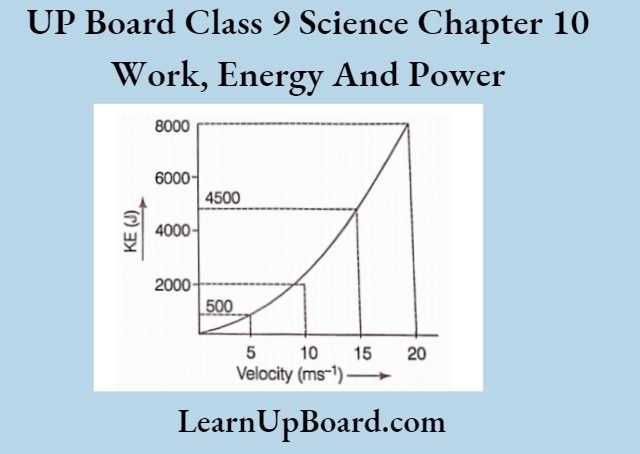
The graph is a parabolic curve because \(\mathrm{KE} \propto v^2\).


